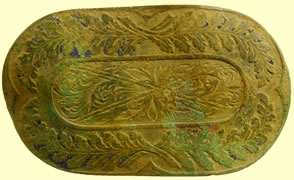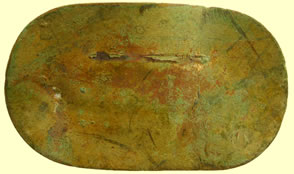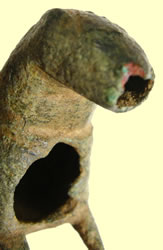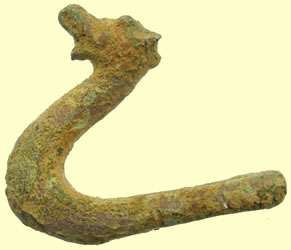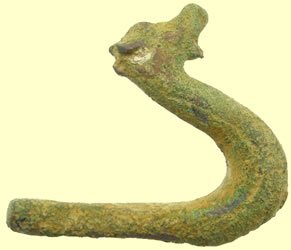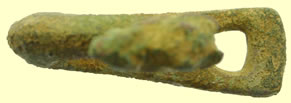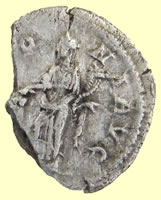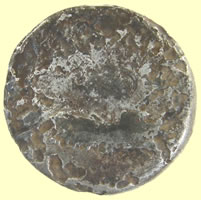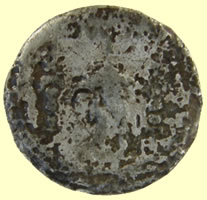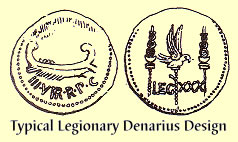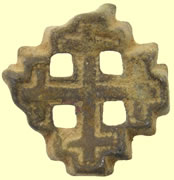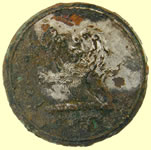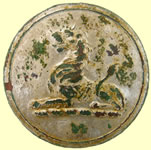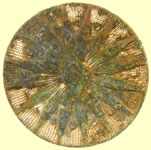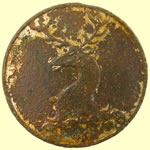

Metal detecting holidays in England with the World's most successful metal detecting club.
Twinned with Midwest Historical Research Society USA
2010 March finds page 2 |
|||||||||||
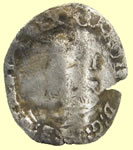 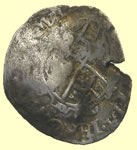 |
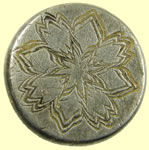 |
 |
|||||||||
1634 Charles 1st hammered silver penny |
Georgian button |
19thC Dragoon guard button |
|||||||||
 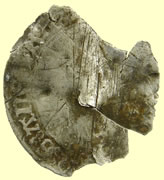 |
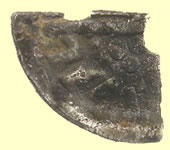 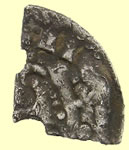 |
||||||||||
1554 Mary hammered silver groat |
1247 Henry III hammered silver voided long cross cut farthing |
||||||||||
16thC Tudor gold on silver cherub mount (left) - reported as treasure. Interesting to compare a similar example (right) we found in the first half of the season curently going through the treasure process. |
|||||||||||
  |
  |
||||||||||
1533-44 Henry VIII hammered silver groat fragment |
19thC religious cross |
||||||||||
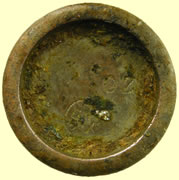 |
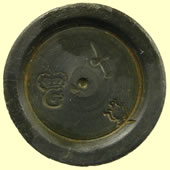 |
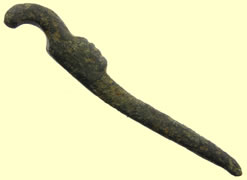 |
|||||||||
20thC Elizabeth II 4oz trade weight |
George 1st trade weight - Crown G cypher - London hall mark |
Roman buckle tongue |
|||||||||
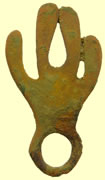 |
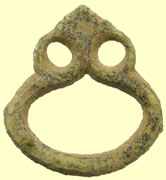 |
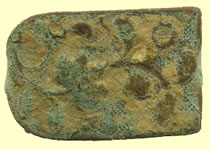 |
 |
||||||||
Surveyer's line marker |
Interesting medieval strap fitting - 2 rivet fixings ? |
18thC decorated clog fastener |
Georgian lock plate |
||||||||
 |
 |
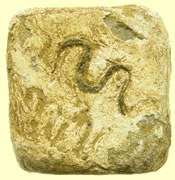 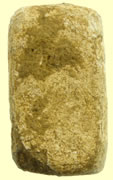 |
|||||||||
Corporation button |
17thC decorated clothing fastener |
Saxon lead gaming piece - black inlaid symbols |
|||||||||
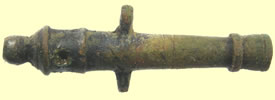 |
  |
||||||||||
18thC toy cannon |
17thC mount with 2 integral lugs |
||||||||||
 |
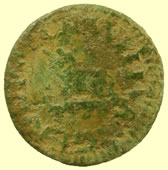 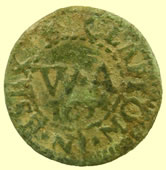 |
||||||||||
18tghC Jews harp |
1654 Will Anger of Clacton Essex hammered copper trade farthing Ref Norweb 1139 |
||||||||||
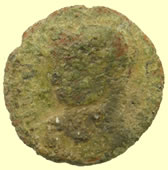 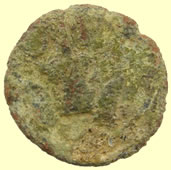 |
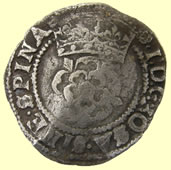 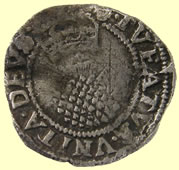 |
||||||||||
4thC Roman bronze |
1607 -9 James 1st hammered silver half groat |
||||||||||
  |
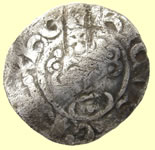 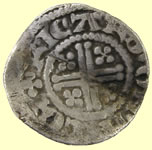 |
||||||||||
1247 Henry III hammered silver voided long cross half penny Moneyer Nicole of Canterbury |
1119 King John hammered silver short cross penny - Class 5a Obv HENRICVS REX Rev RICARD ON NIC(OL Moneyer Ricard of Lincoln mint |
||||||||||
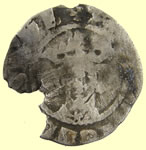 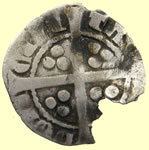 |
 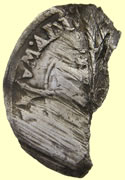 |
||||||||||
1413 -22 Henry V hammered silver penny - Pierced cross
Rev CIVI/TAS/LON/DON - London mint
|
1554 Mary hammered silver groat |
||||||||||
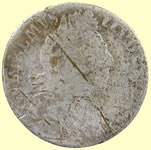 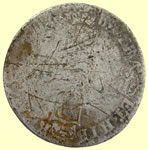 |
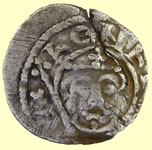 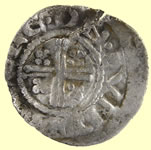 |
||||||||||
1696 William III milled silver sixpence |
1189-99 Richard 1st hammered silver short cross penny Class 4a Obv HENRICVS REX Rev fVLKE( ON LVND -Moneyer Fvlke of London mint |
||||||||||
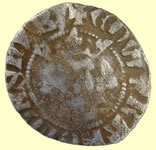 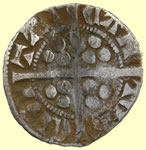 |
  |
||||||||||
1341 Edward III hammered silver penny Obv EDWAR ANGL DNS HYB Rev CIVI/TAS/CAN/TOR - Canterbury mint
|
Taco'd 13thC Medieval hammered short cross penny - needs straightening to ID properly |
||||||||||
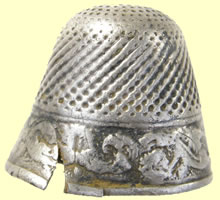 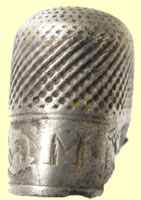 |
 |
||||||||||
18thC silver thimble - initialed M |
Military badge ? |
||||||||||
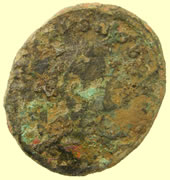 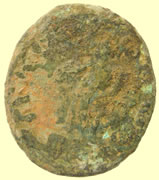 |
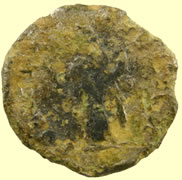 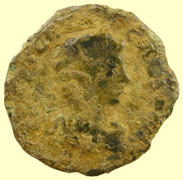 |
||||||||||
27.74mm, 7.81g This appears to be a GENIO POPVLI ROMANI follis of either Galerius as Caesar or Maximinus II as Caesar - this is a little earlier than most of the 4th century material you seem to turn up. This would date to about 305-310 AD. I can't quite read the mint mark - it could be London - but it's generally more likely to be a Western (European) mint rather than an Eastern mint. Mark
|
Crispy Roman silver - in the 'cooker' to remove crust |
||||||||||
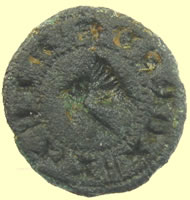 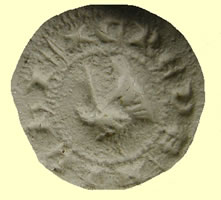 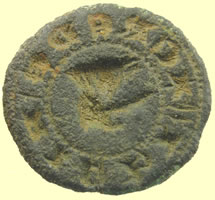 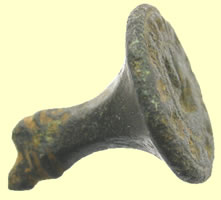 |
|||||||||||
Cleaned up medieval seal matrix, the impression appears to be two birds mating ? Legend *CREDE MICHI II |
|||||||||||
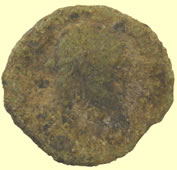 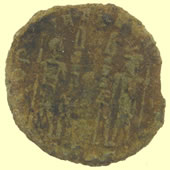 |
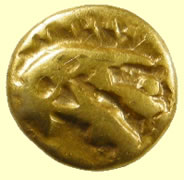 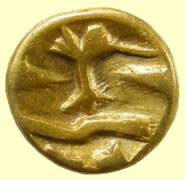 |
||||||||||
Roman bronze sent for ID This one is a two-standard GLORIA EXERCITVS - without a clear obverse legend, I can't say for whom it was struck - and there are at least 4 possibilities - Constantine I and his three younger sons. This type generally dates to about 330-335 AD. These are contemporaneous with the city commemoratives for Rome and Constantinople (like the CONSTANTINOPOLIS you sent earlier today) In about 335, the double standard between the soldiers was changed to a single standard. The single-standard reverse type continued to be used on and off for another 5-10 years.
Mark
|
70BC Morini Celtic gold qtr stater - Sent to CCI for recording 1.44g,10.27mm |
||||||||||
Tenn Brad sent me a picture of a 14thC John the Baptist medallion found in the river Thames and it matches exactly the pendant found by Bil Mark on the Roman hoard field, great find. |
|||||||||||
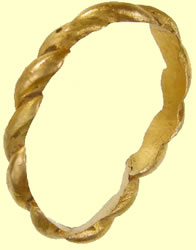  |
|||||||||||
Medeival twisted wire gold ring - no hall marks 22.34mm, 2.73g
|
|||||||||||
Roman 1st/2nd C silver coin as dug and 'cooking' to remove crust |
|||||||||||
Sent to Mark for provisional ID - still cooking it some more 2.84g,17.09mm You probably won't be surprised that I'm not 100% certain on this one, but the obverse looks very like Vitellius - one of the 4 contestants for Nero's throne in 68 AD. Aside from Vespasian - who was the eventual victor - they're all scarce to rare. Vitellius is probably the least rare of the less common three (Galba, Otho & Vitellius), but it's still pretty unusual to encounter one of his denarii.
If I could just get some idea of what was supposed to be happening on the reverse in order that I could confirm that it's among Vitellius' reverse types, I'd probably be pretty certain, but I can't quite figure out what is going on with the reverse.
Mark
|
|||||||||||
18.74mm, 5.62g Outer Band - In memory of Inner inscription - Anna C Round Ob 5th Ap 1822 Maker TM -18 carat Sheffield hallmark 1829 |
|||||||||||
|
|
||||||||||
50 BC Celtic qtr stater sent to CCI for recording and ID - possible Early uninscribed British QC 13.36mm, 1.34g |
Saxon stirrup strap mount - top fixing Type 2A Similar to a design found at Swafield Norfolk |
||||||||||
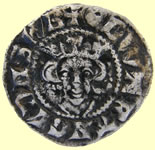 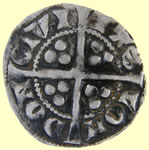 |
  |
||||||||||
1341 Edward III hammered silver florin penny -Cross 3 Obv EDWAR ANGL DNS HYB Rev CIVI/TAS/LON/DON - London mint |
1247 Henry III hammered silver voided half penny - Class 3a Obv HENRICVS REX Rev HEN/RIO/NLV/NDE Moneyer Henri of London mint |
||||||||||
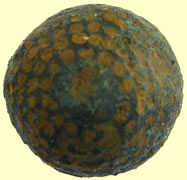 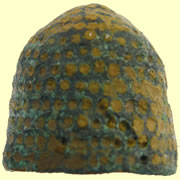 |
  |
||||||||||
12thC medieval beehive thimble |
1180 Henry II hammered silver short cross half penny Class 1b Obv HENRICVS REX |
||||||||||
 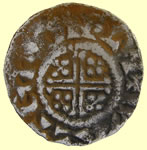 |
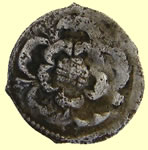 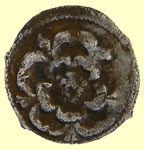 |
||||||||||
1199 John hammered silver short cross penny- Class 5c Obv HENRICVS REX Rev WALTEB ON.LVND Moneyer Walter of London |
Probably one of the smallest hammered silver coins you can find, 1/3rd the weight of a Medieval silver farthing 1625-42 Charles 1st hammered silver half penny - Rose each side - no legend type
0.17g, 9.5mm |
||||||||||
 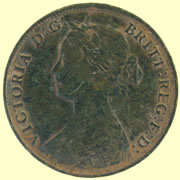 |
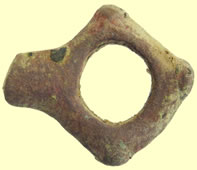 |
||||||||||
Great consition 1861 Victorian milled copper half penny |
c10thC Saxon harness cheek piece fragment |
||||||||||
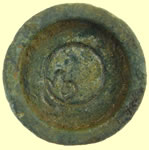 |
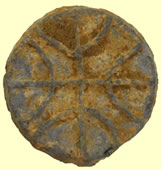 |
 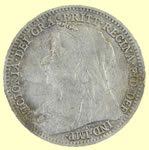 |
|||||||||
Georgian trade weight |
15thC lead token |
1900 Victorian milled silver 3 pence |
|||||||||
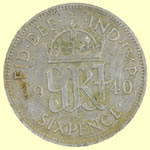 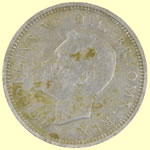 |
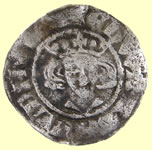 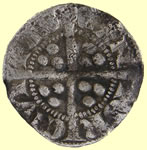 |
||||||||||
1940 George V milled silver sixpence |
1341 Edward III hammered silver florin penny -Cross 3 Obv EDWAR ANGL DNS HYB Rev CIVI/TAS/CAN/TOR - Canterbury mint |
||||||||||
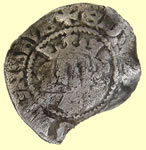 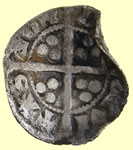 |
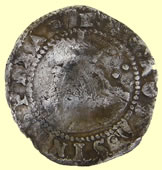 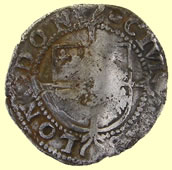 |
||||||||||
1341 Edward III hammered silver florin penny -Cross 3 Obv EDWAR ANGL DNS HYB Rev CIVI/TAS/LON/DON - London mint |
1592-5 Elizabeth 1st hammered silver half groat |
||||||||||
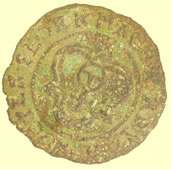 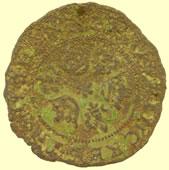 |
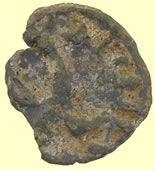 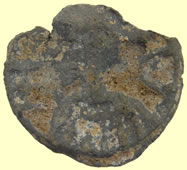 |
||||||||||
1586 Hans Krauwincel II Rose orb Jeton HANNS KRAVWINCKEL IN NVRENB |
Roman lead token |
||||||||||
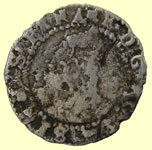 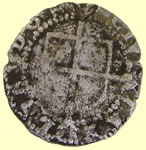 |
  |
||||||||||
1592-5 Elizabeth 1st hammered silver penny |
1818 George III milled silver sixpence |
||||||||||
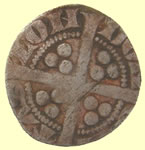 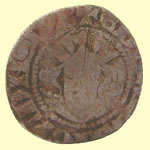 |
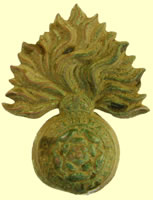 |
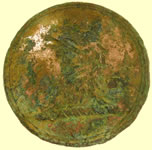 |
|||||||||
1341 Edward III hammered silver florin penny -Cross 3 Obv EDWAR ANGL DNS HYB Rev CIVI/TAS/LON/DON - London mint |
Royal fuseliers cap badge |
19thC livery button |
|||||||||
 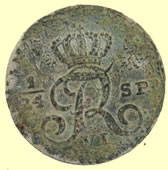 |
 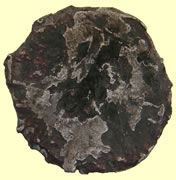 |
||||||||||
1809 Danish 2 1/2 schilling milled silver billion coin |
Interesting Roman silver forgery sent for ID 2.36g, 17.33mm
|
||||||||||
 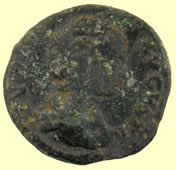 |
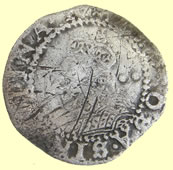 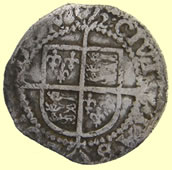 |
||||||||||
4thC Roman bronze sent for ID The coin is unusual - it has AVGVSTA (I think) spelled-out and so is earlier - probably early 3rd century - let me do some research and see who I come up with - I think I see IVLIA on the left, and it could be Domna, although it doesn't much look like her - and I'm curious about the diameter of that one, too - bigger than 18mm, right? - because if it's in the 18mm vicinity, then it's probably a so-called "Limes Denarius".
Mark
|
1602 Elizabeth 1st hammered silver half groat - '2' mint mark
|
||||||||||
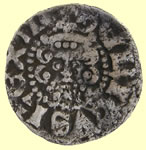 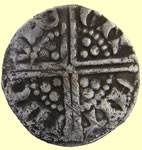 |
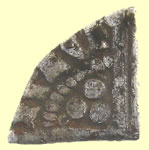 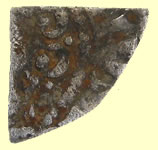 |
||||||||||
1247 Henry III hammered silver voided penny - Class 4ab Obv HENRICVS REX III Rev NIC/OLE/ONC/ANT - Moneyer Nicole of Canterbury mint |
1247 Henry III hammered silver voided qtr penny |
||||||||||
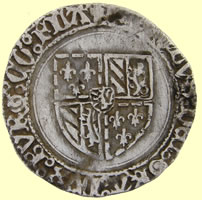 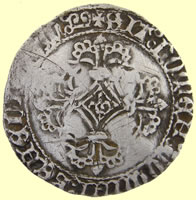 |
|||||||||||
1475 Dutch - Karel de Stoute - hammered silver DOUBLE STUIVER, (Charles the bold) |
|||||||||||
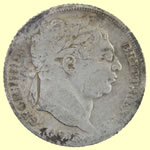 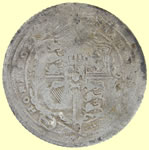 |
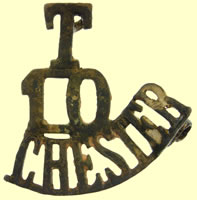 |
||||||||||
1816 George III milled silver sixpence |
20thC 10th Colchester regiment badge |
||||||||||
|
|||||||||||
Early Roman silver coin partially 'cooked' send off to Mark Lehman for ID 16.50mm, 2.57g I found it - it took a while because this is supposed to be a denarius serratus - with a "toothed" edge. These denticles were applied after striking, evidently - a stack of coins was held in some sort of clamp and a file or saw-blade of some sort was applied lenghthwise to the pile cutting 25 or 30 grooves or notches in the edges of all the coins - or it's supposed to work this way. If you look very carefully at the obverse, you can see 4 or 5 very shallow indentations on the rim between about 1:00 & 4:00 - so this is an almost serrate denarius.
It dates to 81 BC. - C. Marius C.f. Capito (RSC/Babelon Maria 9) the coin has "SC" in the reverse exergue indicating that the senate had authorized a significant increase in the quantity of coins originally this quaestor was sanctioned to strike.
Obv: CAPIT XXVIIII (control number) behind head of Ceres right, wreathed in corn.
Rx: C MARI C F beneath plowman guiding yoke of oxen left; SC in exergue.
SR 300, Syd.CRR 744b.
So, it's not tremendously early - it dates to the period just before the dictatorship of Sulla.
Mark
|
|||||||||||
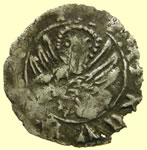 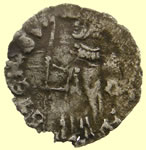 |
|
||||||||||
Venetian Soldino issued by Doge Michele Steno (1400-1413). Doge standing left, holding banner, * / m in right field |
Huge medieval key |
||||||||||
Pilgrim ampullae - holly water bottle made of lead 12th to 15thC, Scallop shell type with merchant shield on reverse These ampoule were brought from pilgrimage places as a souvenir Mitchiner suggests that many ampullae were used in the annual springtime ’Blessing the Fields’ ceremony, in which the Holy Water they contained was sprinkled on the ground to give prayer for a good harvest. Having served this purpose, Mitchiner suggests that the ampullae were discarded. Others have suggested that the ampullae were buried along with their contents for a similar purpose. |
|||||||||||
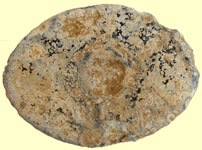  |
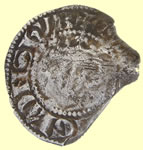 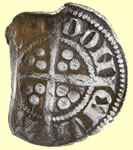 |
||||||||||
Interesting vessica shaped seal - more like a Georgian style stamp |
1279 Edward 1st hammered silver penny - Cross potent - Class 10ab Obv EDWAR ANGL DNS HYB Rev CIVI/TAS/LON/DON - London mint |
||||||||||
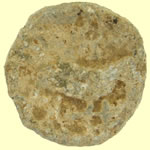 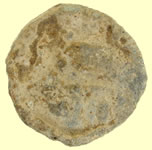 |
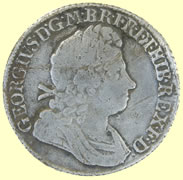 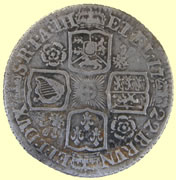 |
||||||||||
Roman lead token |
Stunning 1722 George 1st milled silver sixpence |
||||||||||
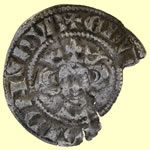 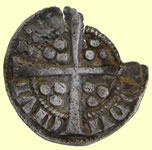 |
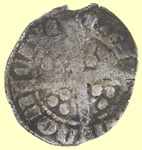 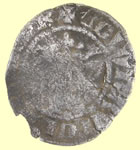 |
||||||||||
1341 Edward III hammered silver florin penny -Cross 3 Obv EDWAR ANGL DNS HYB Rev CIVI/TAS/LON/DON - London mint |
1341 Edward III hammered silver florin penny -Cross 3 Obv EDWR ANGL DNS HYB Rev CIVI/TAS/LON/DON - London mint |
||||||||||
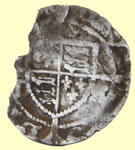 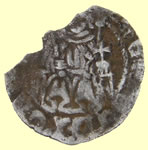 |
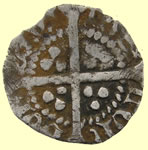 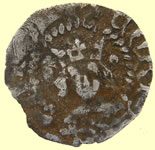 |
||||||||||
1426-44 Henry VIII hammered silver sovereign penny - 2nd coinage Obv King enthroned holding orb and sceptre - TW by shield ArchBp Wolsey - Durham mint |
1413-22 Henry V hammered silver half penny - broken annulet to left and pellet to right by crown Note The pellets seem to have been produced by converting broken annulets on dies. They may appear whole or 'nicked' depending on the accuracy and force with which they are applied within the annulet Obv HENRICVS REX Rev CIVI/TAS/LON/DON - London mint |
||||||||||
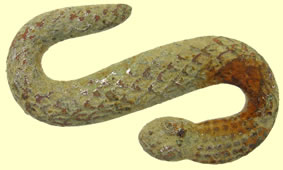 |
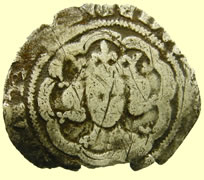 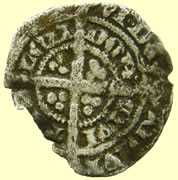 |
||||||||||
19thC snake buckle |
1483 Edward V hammered silver groat - Halved sun and rose mint mark Obv EDWA *** Rev CIVI/TAS/LON/DON - London mint |
||||||||||
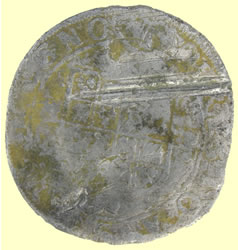 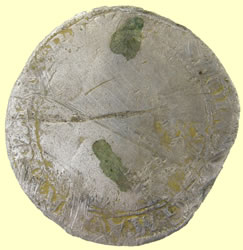 |
|||||||||||
Monster silver find - our first ever large denomination Charles II silver coin 1660-85 - Charles II milled silver half crown (30 pence) 3rd issue |
|||||||||||
|
|||||||||||
4thC Roman bronze sent for ID The two at the top are common Constantinian family types - the 2nd is definitely a 2-standard GLORIA EXERCITVS - the one at the top, I'm not as sure what's going on - is it two standing figures? - if so, it might be a VICTORIAE LAETAE PRINC PERP with 2 Victories holding a shield over a short column, or possibly a Gloria Ex, although it doesn't strike me immediately as a Gloria Ex, I suppose it could be a single-standard type.
The coin on the bottom, however, is unusual - it has AVGVSTA (I think) spelled-out and so is earlier - probably early 3rd century - let me do some research and see who I come up with - I think I see IVLIA on the left, and it could be Domna, although it doesn't much look like her - and I'm curious about the diameter of that one, too - bigger than 18mm, right? - because if it's in the 18mm vicinity, then it's probably a so-called "Limes Denarius".
Mark
|
|||||||||||
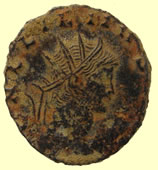 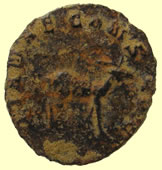 |
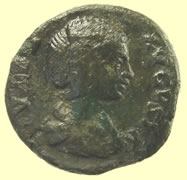 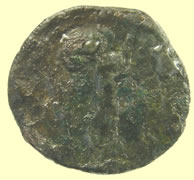 |
||||||||||
Cracking condition Roman bronze sent for ID 19.27, 1.92g
This one, in case you couldn't read it, is an antoninianus of Gallienus (sole reign, 26-268 AD) this belongs to the so-called "Zoo" series of coins with various animal reverses.
This one has a reverse legend of DIANAE CONS AVG and shows an antelope or a stag (elk) (I'm not completely sure which) walking right. A nicer specimen (I happen to be working with a Gallienus zoo collection at the moment)
w/ antelope - http://www.stoa.org/gallery/album430/10_CR_GAZOO -
This series, naming various deities - Apollo, Diana, Hercules, Jupiter, Liber/Bacchus, Neptune & Sol was issued in the last couple years of Gallienus' reign 267/8
Mark
|
Roman silver coin with green crust - cooking it to remove crud - sent for ID 16.23mm, 2.95g it's a denarius of Julia Domna, on whom I gave you a lot of background earlier today. Wife of Septimius Severus, etc. I believe, although it's difficult to be sure given the condition, that the reverse type is VENVS VICTRIX - which is a fairly common reverse type for Domna.
Mark
|
||||||||||
|
As dug
Starting to 'cook' it
|
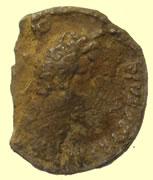 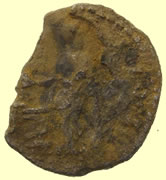 |
||||||||||
Roman silver coin - cooking to remove green crud - sent to mark Lehman for provisional ID 19.77mm You seem to be getting a lot of unintended small change lately - This is a denarius of Severus Alexander - the last member of the Severan Dynasty, 222-235 AD. This one should read: IMP C M AVR SEV ALEXAND AVG on the obverse and ANNONA AVG on the reverse. In addition to the missing parts, there seems to be either a squashed letter "A" or a letter "I" in error at the end of ANNONA. Annona was the allegorical personification of the grain supply - yes, it was THAT important to the Romans so that it required a minor deity to be "in charge" of imported grain. She's shown holding a handful of grain-ears and a cornucopia. What I can't tell is whether she has her foot on a ship's prow or there's a modius - a grain-measure basket - at her feet since that bit is missing. If it's the ship's prow, this coin dates to 228 - if it's the modius, it's 226. For our purposes, we can assume that all the silver was struck at the mint in Rome at this point in time.
Mark
|
Roman silver coin - in the 'cooker' to remove horn silver crust |
||||||||||
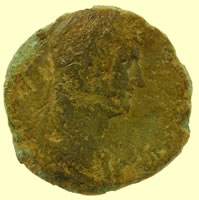 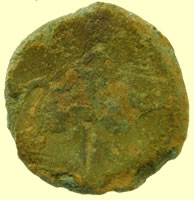 |
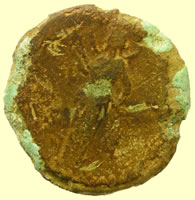 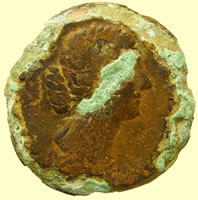 |
||||||||||
Large Roman 1st/2ndC AS sent for ID
These are AE's of Faustina II, wife of Marcus Aurelius (I believe - it could be Lucilla, but she's not as likely as Faustina) and Hadrian. I can't quite figure out what's happening on the reverse of the Hadrian - looks like a transverse chain? Nothing I'm immediately familiar with, at any rate. perhaps it is 45º rotated to clockwise and I'm seeing a shield and the outline of drapery and an arm? If so, could be a lot of different things, but Roma, Mars & Virtus come to mind - all would have grounded shields.
The Faustina/Lucilla Rx is a Diana Lucifera type - Diana holding a long torch transversely.
Mark
|
Large Roman 1st/2ndC AS sent for ID These are AE's of Faustina II, wife of Marcus Aurelius (I believe - it could be Lucilla, but she's not as likely as Faustina) and Hadrian. I can't quite figure out what's happening on the reverse of the Hadrian - looks like a transverse chain? Nothing I'm immediately familiar with, at any rate. perhaps it is 45º rotated to clockwise and I'm seeing a shield and the outline of drapery and an arm? If so, could be a lot of different things, but Roma, Mars & Virtus come to mind - all would have grounded shields.
The Faustina/Lucilla Rx is a Diana Lucifera type - Diana holding a long torch transversely.
Mark
|
||||||||||
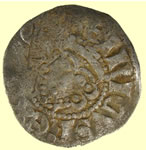 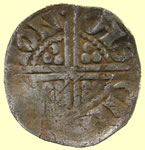 |
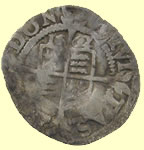 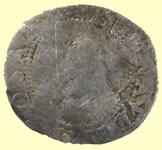 |
||||||||||
1247 Henry III hammered silver voided penny - Class 2b Obv HENRICVS REX III Rev ION/ONS/EDM/VND- Moneyer Ion of Bury St Edmunds mint |
1562 Elizabeth hammered silver penny |
||||||||||
|
|||||||||||
Stunningly beautiful - Romano/British bronze razor back pig/hog offering ? red enamelled eyes - 65.56mm L x 39.9mm H 148g
|
|||||||||||
  |
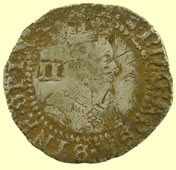 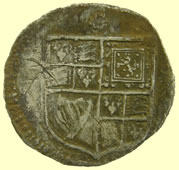 |
||||||||||
Interesting Edward cut half with a legend ending in Rex not in the book - needs more research Rev CIVI/TAS/LON/DON - London mint |
1604-19 James 1st hammered silver half groat |
||||||||||
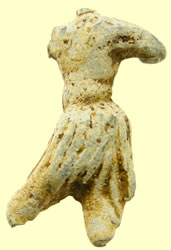 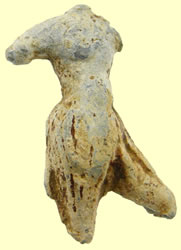 |
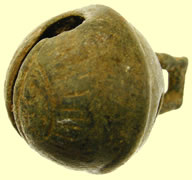 |
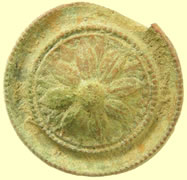 |
|||||||||
Roman lead figurine |
Lots of real nice undamaged crotal bells being found from all periods- some have clear founday marks |
Georgian harness mount |
|||||||||
 |
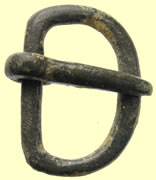 |
  |
|||||||||
18thC jews harp |
Medieval buckle |
Roman hooked clothing fastener |
|||||||||
 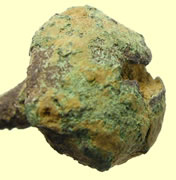 |
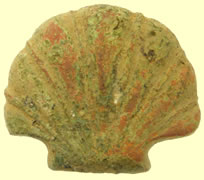 |
||||||||||
Unusual elongated Tuor style button/pin |
18thC Knife handle guard |
||||||||||
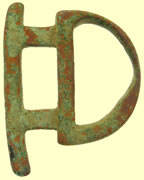 |
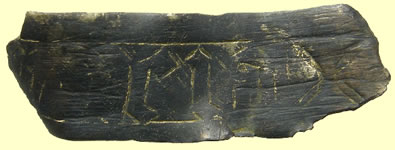 |
||||||||||
We have found several of this type before but not in the ref books, ckearly a harness buckle but what date and its use ? |
Early script on silver fragment - possible 17thC report to museum as treasure |
||||||||||
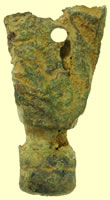  |
  |
||||||||||
Interesting widget ? |
Georgian copper alloy brooch |
||||||||||
  |
 |
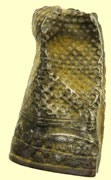 |
|||||||||
1750 Portuguese copper coin |
Army medical corp cap badge |
Georgian decorated silver thimble |
|||||||||
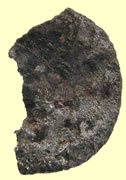 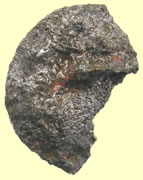 |
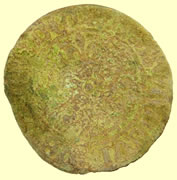 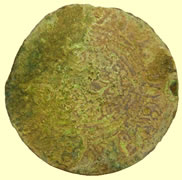 |
||||||||||
Roman silver coin forgery - you can see clearly the copper core has seeped through
Although "fourree" silver-over-copper denarii are not terribly uncommon, they tend to be seen more in the Republic and early Imperial era, however. Those silver foil-wrapped copper cores, the foil sealed to the core with flux and the whole package struck with dies was the "standard" for counterfeits - ie: fakes made to deceive and pass current as good silver denarii for a long time. |
Interesting 16thC jetton - need to check ref books on this one |
||||||||||
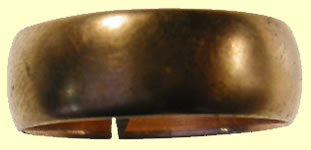 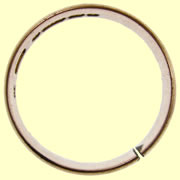 |
|||||||||||
1890 9 carat gold ring - Birmingham hall mark - Marker JM 3.36g, 18.95mm |
|||||||||||
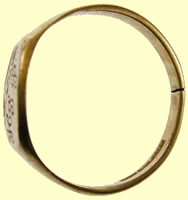 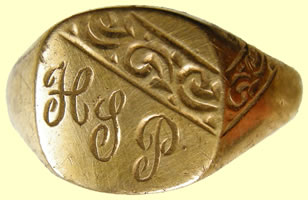 |
|||||||||||
Man's gold signet ring - inscribed LW Maker P&G 9 carat Date letter W - still working on the date 4.70g, 23.32mm |
|||||||||||
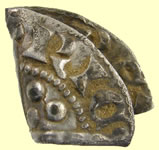 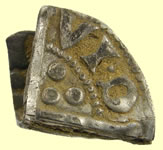 |
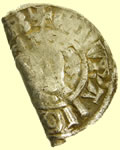 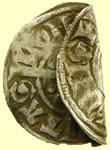 |
||||||||||
1247 Henry III hammered silver voided half penny Rev DA/VID/ |
1279 Edward 1st hammered silver penny -Cross Potent Obv EDWR ANGL DNS HYB Rev CIVI/TAS/LON/DON - London mint |
||||||||||
 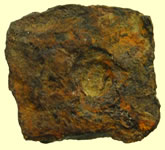 |
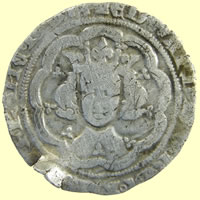 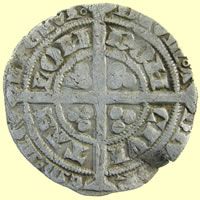 |
||||||||||
Medieval mount |
1351-2 Edward III hammered silver groat - Cross 1 Series D Closed C & E's Rev CIVI/TAS/LON/DON - London mint |
||||||||||
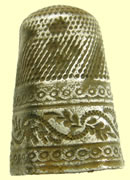 |
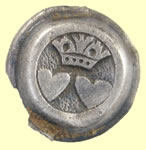 |
 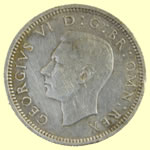 |
|||||||||
Georgian decorated silver thimble |
17thC Charles II silver button - reported as treasure | 1937 George V milled silver sixpence |
|||||||||
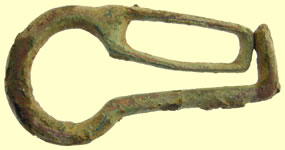 |
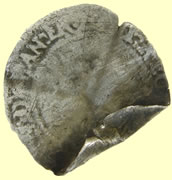 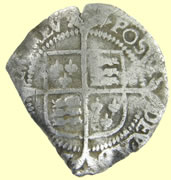 |
||||||||||
Interesting strap type widget - one for the museum |
1485 -1509 Henry VII hammered silver groat |
||||||||||
  |
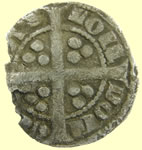 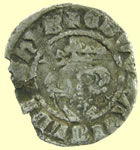 |
||||||||||
1216 Henry III hammered silver short cross half penny Obv HENRICVS REX Rev ** RI.ON.C **** Moneyer Henri Canterbury mint |
1341 Edward III hammered silver florin penny -Cross 3 Obv EDWR ANGL DNS HYB Rev CIVI/TAS/LON/DON - London mint |
||||||||||
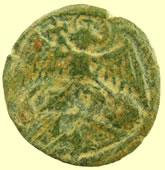 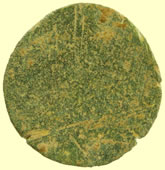 |
 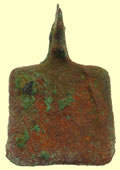 |
||||||||||
15thC Angel coin coin weight - bent right leg Circa 1493 - British |
Medieval golded harness pendant |
||||||||||
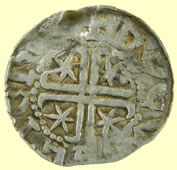 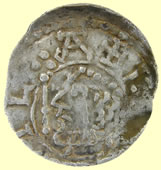 |
|||||||||||
1205 Willam 1 The Lion - Scottish hammered silver penny Obv WILAM Rev HUE WALTER Moneyer Walter of Perth, Edinburgh and Roxburgh mints |
|||||||||||
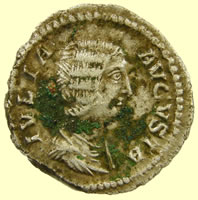 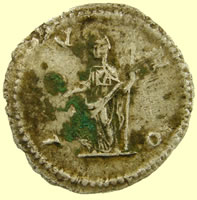 |
|||||||||||
Another silver Roman with green grunge' growing on it - sent for ID 18.65mm, 2.57g Yes indeed - if they all came out of the ground looking like this, you wouldn't have much use for me! This is, of course, Julia Domna, wife of Septimius Severus, mother of Caracalla & Geta, great-aunt of Elagabalus & Severus Alexander. Septimius Severus married her in 188 because of a fortuneteller's prediction that she would be an empress - and so she was, in fairly short order, Severus donning the purple on the downfall of Didius Julianus in 193.
It wasn't all roses and luxury, however, she accompanied her husband all around the Roman world during the last 5 years of his military career, and her younger son, Geta, was murdered before her eyes and died in her arms after being tricked by older brother Caracalla into attending a banquet at which they were supposed to renounce their earlier antagonism and share the empire between them as Dad Severus had intended before his death at York in 211 - Julia accompanied him on this campaign, as did Caracalla.
She outlived her family (not all that unusual for Imperial women), but not for long, committing suicide by self-starvation in late 217. Coins were struck in her honor under both Septimius and Caracalla and she was the first woman to be portrayed on Caracalla's new denomination, the antoninianus or double denarius.
This is a denarius, of course, and the reverse type is the simple IVNO - (Domna as) Juno holding a patera to feed a peacock - which isn't quite visible behind the green encrustation to her left - and a scepter. This type, struck under Septimius Severus, dates about 209 AD, and is considered common - although the condition of this specimen is anything but common for your area - the denarii were still relatively good silver at this time, however, and had a lot less base metal in the alloy to corrode and degrade.
RIC 559, RSC 82, SR 6588.
Mark
|
|||||||||||
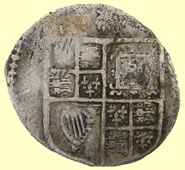 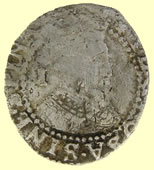 |
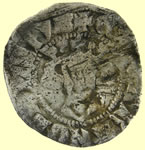 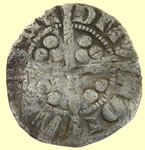 |
||||||||||
1604-4 James 1st hammered silver penny |
1279 Edward 1st hammered silver penny -Class 10ab Obv EDWAR ANGL DNS HYB Rev VILL/SCIE/DMV/NDI - Bury St Edmunds mint |
||||||||||
  |
  |
||||||||||
1180 Henry II hammered silver short cross- cut half penny - Class 1a |
1247 Henry III hammered silver voided long cross cut half penny Obv HENRICVS REX III Obv HEN/RIO/NLV/NDE - Moneyer Henri of London mint |
||||||||||
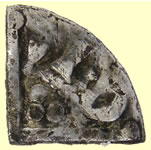  |
  |
||||||||||
1247 Henry III hammered silver voided long cross cut farthing |
Medieval Venetain soldino silver hammered coin |
||||||||||
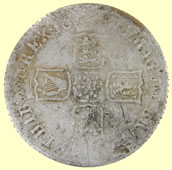 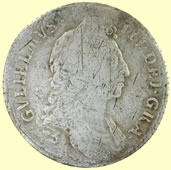 |
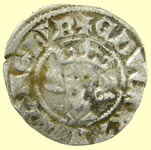 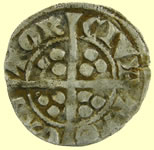 |
||||||||||
1696 William III milled silver shilling |
1341 Edward III hammered silver florin penny Obv EDWAR ANGL DNS HYB Rev CIVI/TAS/CAN/TOR Canterbury mint |
||||||||||
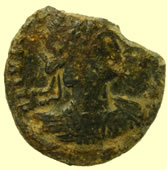 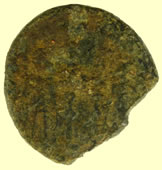 |
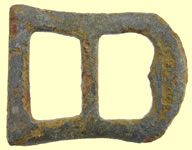 |
 |
|||||||||
4thC Roman bronze sent for ID that appears to be a "Contemporary Copy" of a Constantinian-era GLORIA EXERCITVS type - 2 soldiers flanking 2 standards. The prototype dates to 330-335 AD. and copies would be from about the same time or just a year or two later.
Mark
|
1550-1650 buckle |
Georgian gold plates watch winder |
|||||||||
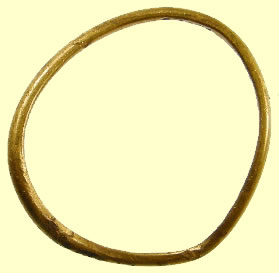  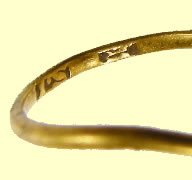 |
|||||||||||
Medieval gold ring - inscribed LUV - reported as treasure to museum 0.74g, 16.74mm |
|||||||||||
  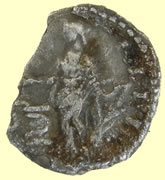 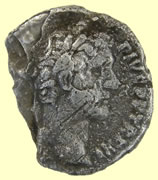 |
|||||||||||
Cooked Roman silver sent for ID 1.43g, 17.71mm This is a denarius (well, most of one anyway) of Antoninus Pius - 138-161 AD. The reverse type is a bit more difficult to tell since the really interesting bit is almost completely off the coin. It's Salus, the personification of the soundness or "health" of the Empire standing left and feeding from a patera a serpent arising from the short altar at her feet. You can just see the tip of its head at the end of her arm and you can see a loop & coil of body hanging off the altar if you know what you're looking at.
The reverse legend would be COS IIII which doesn't tell us a whole lot except that this coin was struck during or after his 4th consulship - 145-161, but add to the calculations the TR P date of XI from the obverse legend and we can date it to 147/8 AD.
Mark
|
|||||||||||
 |
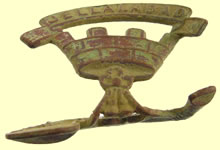 |
||||||||||
Medieval shield pendant hanger - 3 rivet fixings |
Rifle regiment cap badge |
||||||||||
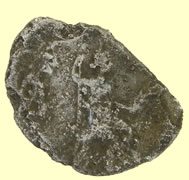 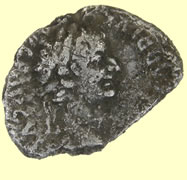 |
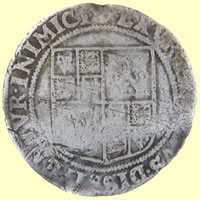 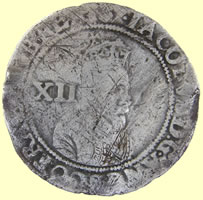 |
||||||||||
Roman silver coin sent for ID 1.85g, 19.11mm This is our old friend Tiberius - again! - it's the ever-popular, so-called "Tribute Penny" of which you seem to find many. There probably were plenty of them still in circulation at the time of Claudius' invasion. Tiberius for all practical purposes only struck this one type of denarius throughout his long (14-37 AD) reign. If it were not for the (somewhat dubious) "biblical reference" which causes this coin-type to be of interest to non-numismatic folks who want it for its supposed biblical link, it would be, rather than one of the most desireable and expensive, one of the cheapest and most common 1st century denarii.
Mark
|
1619-25 James 1st hammered silver shilling (XII pence) 3rd coinage |
||||||||||
  |
|||||||||||
Cracking find - 18th/19thC Lion headed sword hanger |
|||||||||||
 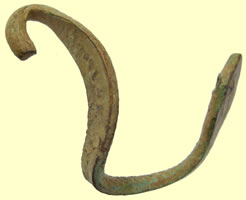 |
|||||||||||
Snake clasp ? TD & C Patent 1546 |
|||||||||||
 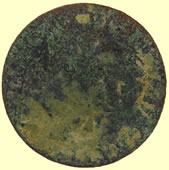 |
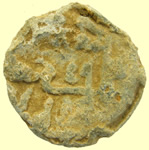 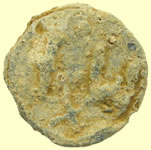 |
||||||||||
1784 Continental copper coin |
Roman lead token |
||||||||||
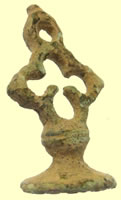 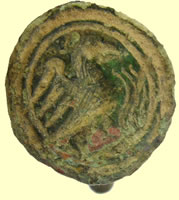 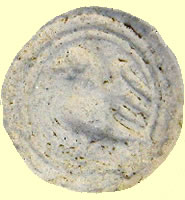 |
|||||||||||
16thC seal matrix with bird impression |
|||||||||||
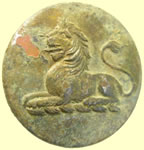 |
 |
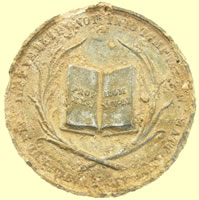 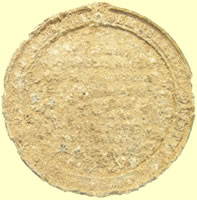 |
|||||||||
19thC livery button |
Military button ? |
Huge medallion - needs cleaning to deciper it |
|||||||||
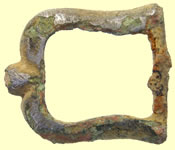 |
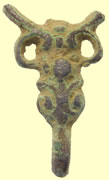 |
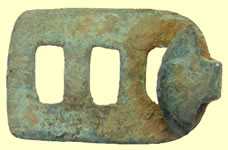 |
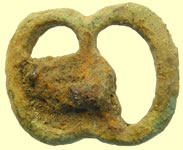 |
||||||||
Georgian buckle |
16thC Tudor clothing fastener |
18thC clog fastener |
1550-1650 buckle |
||||||||
 |
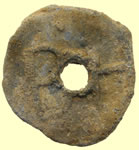 |
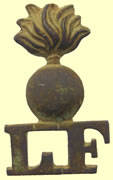 |
|||||||||
Early medieval gilded harness pendant - circle decoration |
17thC lead token |
Military cap badge |
|||||||||
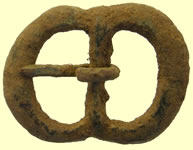 |
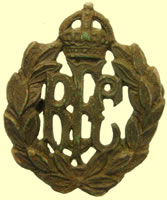 |
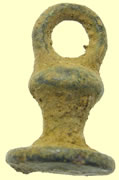 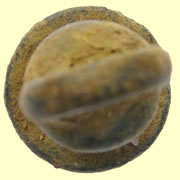 |
|||||||||
1550-1650 buckle |
Great find WWI Royal flying corp cap bdge |
Georgian bell type trade weight |
|||||||||
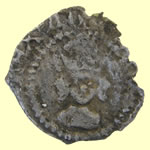 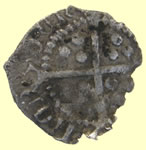 |
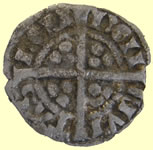 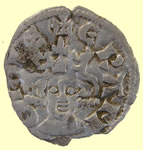 |
||||||||||
Tiny 1485 Henry VII hammered silver halfpenny - rev cross fourchee - wide hair bust - Type 3 single arched crown Obv HENRIC DI GRA REX A Rev CIVI/TAS/LON/DON - London mint |
Great find, known obverse die error 1327 Edward III hammered silver penny Obv ER ANGL **** Rev CIVI/TAS/LON/DON - London mint |
||||||||||
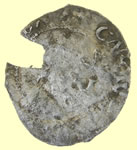 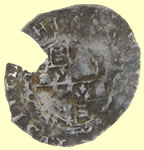 |
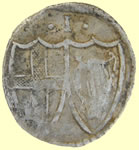 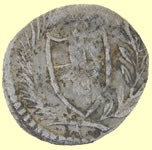 |
||||||||||
1634 Charles 1st hammered silver penny |
1649 Commonwealth hammered silver penny |
||||||||||
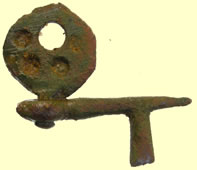 |
  |
||||||||||
Crudely made Georgian watch winder |
17thC decorated finger ring |
||||||||||
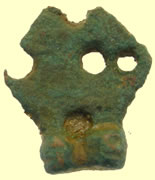  |
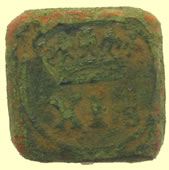 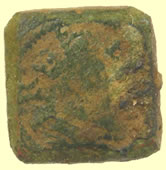 |
||||||||||
c 10thC Saxon stirrup fitting |
1619 James 1st XIs Double crown gold coin weight -2nd coinage revalued |
||||||||||
|
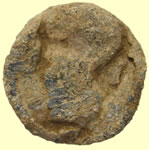 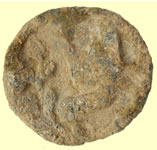 |
||||||||||
Medieval swivel strap guide |
Roman lead token Obv Roman bust Rev One figure standing - one seated |
||||||||||
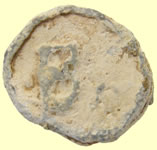  |
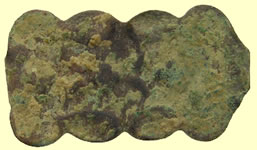 |
||||||||||
17thC lead token |
18thC clog fastener |
||||||||||
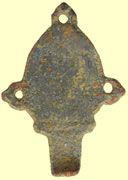 |
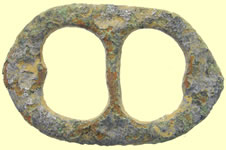 |
 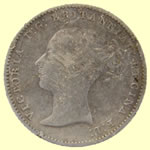 |
|||||||||
17thC clothing fastener |
1550-1650 buckle |
1845 Victorian milled silver groat |
|||||||||
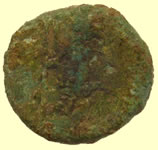 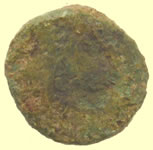 |
  |
||||||||||
4thC Roman bronze coin - sent for ID |
17th mount with 2 integral lugs |
||||||||||
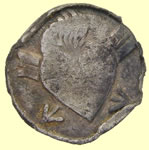 |
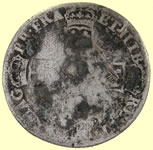 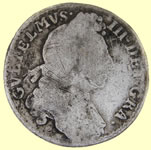 |
||||||||||
17thC Charles II silver button - reported as treasure |
1696 William III milled silver sixpence |
||||||||||
  |
  |
||||||||||
1215 Henry III hammered silver short cross half penny London mint |
1180 Henry II hammered silver short cross half penny - Class 1b Obv HENRICVS REX Rev * RAVL.ON ** - Moneyer Ravl |
||||||||||
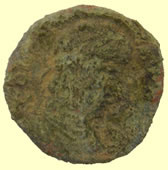 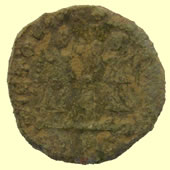 |
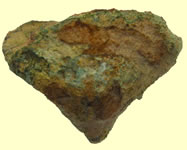 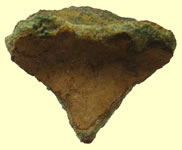 |
||||||||||
4thC Roman bronze coin - sent for ID either Constans or Constantius II - the reverse type, VICTORIAE DD AVGG Q NN - 2 victories facing each other holding wreaths - was only struck in 347 & 348 so it's a good type for dating a site. The obverse is too badly compromised for me to tell from the photo whether it's Constans or Constantius - nothng particularly special about either one, they were brothers and sons of Constantine I "The Great". Constans would live another 2 years and Constantius another 15 or so, but they were petty much "interchangeable" at this point in time, except that one dealt with the western part and the other the eastern part of the Empire. Mark |
1stC Roman fibular brooch fragment |
||||||||||
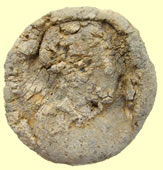 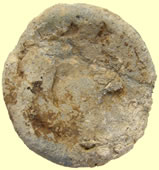 |
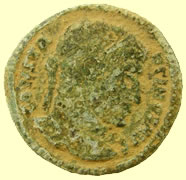 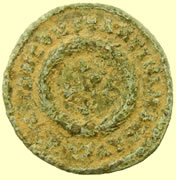 |
||||||||||
Roman lead token Obv Roman bust |
Unusual Roman bronze sent for ID 20.75mm,3.22g Constantine I "The Great" (307-337) - this AE3's reverse has "D N CONSTANTINI MAX AVG" around a small wreath in which is the Vota vow "date"- "VOT / XX" It also has a somewhat unusual obverse legend-break - "CONSTA - NTINVS AVG" - they're usually broken more symmetrically.
I can't read the mint mark - if this cleans up at all and we can read the exergue (in this photo, the reverse is rotated 45º clockwise of proper orientation - the mint mark would be at the bottom, under the wreath-ties) I can tell you where it's from - in general though, the "when" is about 320-324 (it wasn't unusual for emperors to "anticipate" their vows by half a decade or more.
If I could see the mint mark, I could say both where it was struck and narrow-down the time frame to a year or a few months, depending.
Mark
|
||||||||||
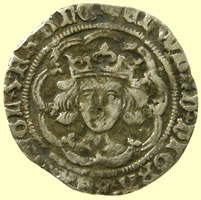 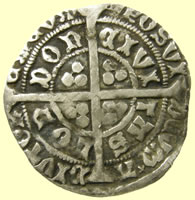 |
|||||||||||
1471 Edward IV hammered silver groat Obv EDWARD DI GRA REX ANGL Z FRANC Rev CIVI/TAS/LON/DON - London mint |
|||||||||||
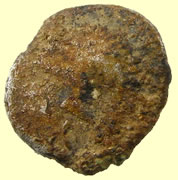 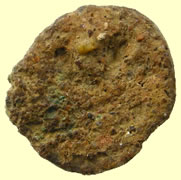 |
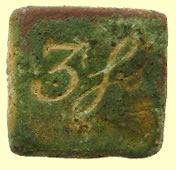 |
||||||||||
Under this crust is a Roman silver coin - straight into the 'cooker' to eat off the crud |
18thC apothecary weight |
||||||||||
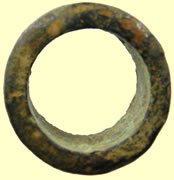  |
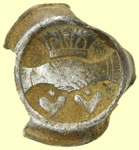 |
||||||||||
Thick copper alloy ring - possible medieval harness type |
17thC Charles II silver button - reported as treasure |
||||||||||
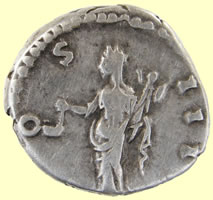 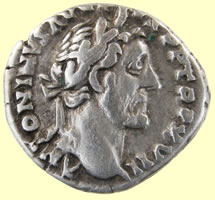 |
|||||||||||
Best condition Roman silver I have ever seen dug- next to fresh water spring ! Probably an offering Sent off for ID 16.3mm,3.39g This is a denarius of Antoninus Pius, 138-161- there are many who consider his reign the height of the golden era of Imperial Rome. There was so little strife, war, plague or disaster that the result is that there's very little written about him or his times other than "He was known as the fairest and wisest of rulers and blah..." Of course from the British perspective, he's important for having built the second wall, north of Hadrian's. From the dates which are parts of his titles in the legends, this coin dates to 153/4. The reverse shows Vesta, the special deity of the Roman hearth and home standing left holding a simpulum - a ceremonial ladle which was part of the set of priestly implements portrayals of the set of which were an emblem of the priestly colleges, and the Palladium, sort of a short, thick scepter with a figure of Pallas/Athena at its end. Supposedly brought to Rome out of the ruin of Troy by Aeneas, it was considered a special symbol of the city's - and by extention, the empire's - devine protection.
Mark
|
|||||||||||
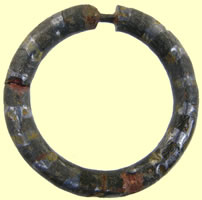 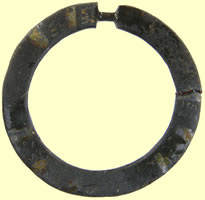 |
|||||||||||
Stunning silver inlaid medieval annular brooch 24.86mm, 2.77g |
|||||||||||
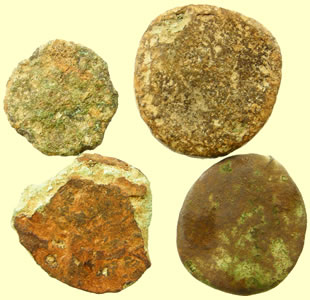 |
 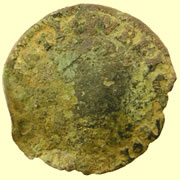 |
||||||||||
Lots of Roman 'grots' being dug, best ones sent to Mark Lehman for his ID |
Continental jetton ? |
||||||||||
Roman writing stylus |
|||||||||||
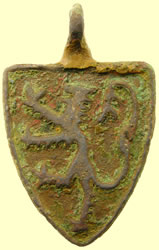  |
|||||||||||
Stunning c13thC Heraldic shield pendant- red enamel and gilding remaining |
|||||||||||
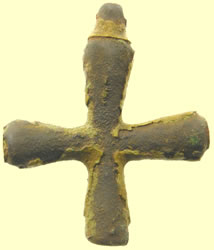  |
|||||||||||
c13thC Cross pendant - thick gold plating remains |
|||||||||||
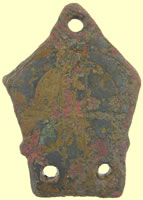 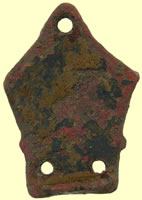 |
 |
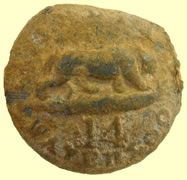 |
|||||||||
c10thC Saxon stirrup alloy termninal - Class A type 1 |
Medieval casket key |
Superb find 19thC 14th Regiment of foot button India Waterloo |
|||||||||
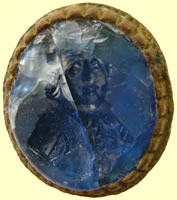 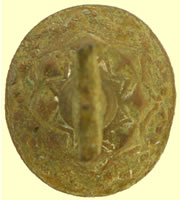 |
 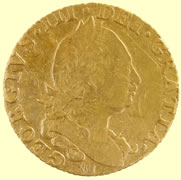 |
||||||||||
Really neat Georgian glass fob seal - mans bust impression |
1777 George III gold half guinea |
||||||||||
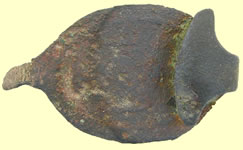 |
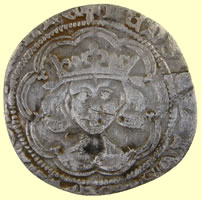 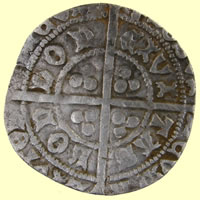 |
||||||||||
18thC clog fastener |
1461 Edward IV hammered silver groat-First reign -Initial mark Long cross fitchee Trefoils on cusps except above crown Obv EDWARD DI GRA REX ANGL Z FRANC Rev CIVI/TAS/LON/DON - London mint |
||||||||||
  |
|
||||||||||
17thC mount with 2 integral lugs |
Interesting measure - apothecary ? |
||||||||||
  |
  |
||||||||||
Crude Saxon hooked fastener - 2 rivet fixings |
1249 Alexander Scottish hammered silver half penny Moneyer Robert |
||||||||||
 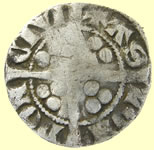 |
 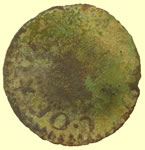 |
||||||||||
1341 Edward III hammered silver florin penny -Cross 3 Obv EDWAR ANGL DNS HYB Rev CIVI/TAS/LON/DON - London mint |
1666 Giles Tayspill of Colchester Essex hammered copper trade farthing Ref Norweb 1227a |
||||||||||
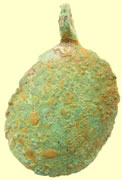 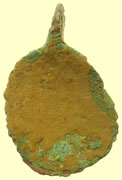 |
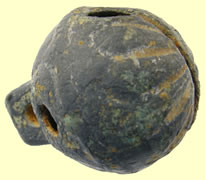 |
||||||||||
Medieval hanging pendant - enamelling could still be under the crud |
Lots a nice early complete decorated crotal bells being dug up |
||||||||||
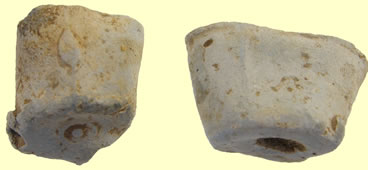 |
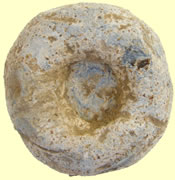 |
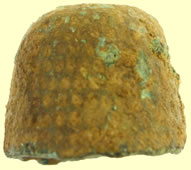 |
|||||||||
1640's lead gunpowder measures and cap - one on left is the first one I have seen decorated |
Huge medieval lead trade weight |
c12thC bronze beehive thimble |
|||||||||
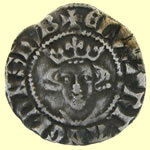 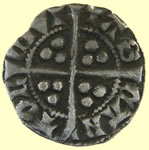 |
 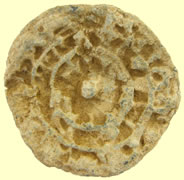 |
||||||||||
1361-1369 Edward III treaty period hammered silver penny Obv EDWARD ANGL DNS HYB Rev CIVI/TAS/CAN/TOR Canterbury mint |
Medieval 'boy bishop' style lead token |
||||||||||
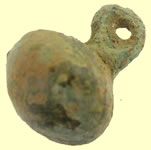 |
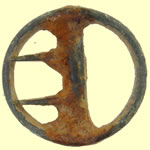 |
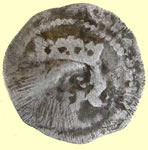 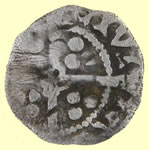 |
|||||||||
16thC Tudor button |
Georgian buckle |
1422 Henry VI hammered silver penny - York mint - Archiepiscopal issue Quatrefoil with pellet at centre of reverse cross |
|||||||||
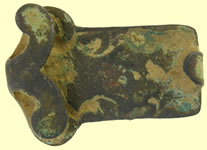 |
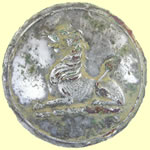 |
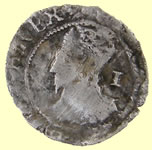  |
|||||||||
18thC clog fastener |
19thC livery button |
1641-3 Charles 1st hammered silver penny - mintmark 2 dots |
|||||||||
 |
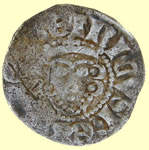  |
||||||||||
20thC inlaid button |
1247 Henry III hammered silver voided long cross penny - Class 5a Rev ION/ONS/EDM/VND - Moneyer Ion - Bury St Edmunds mint |
||||||||||
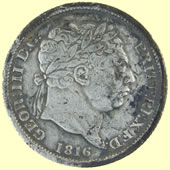 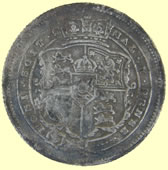 |
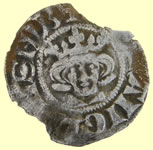 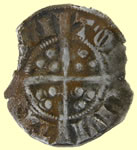 |
||||||||||
1816 George III milled silver shilling |
1279 Edward 1st hammered silver penny - Cross potent Rev CIVI/TAS/CAN/TOR - Canterbury mint |
||||||||||
 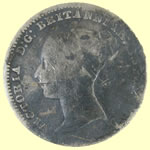 |
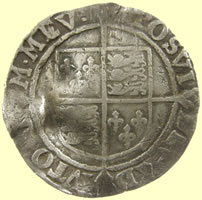 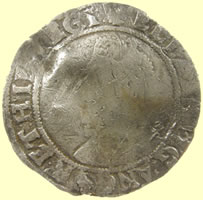 |
||||||||||
1854 Victoria milled silver groat |
1585-6 Elizabeth 1st hammered silver shilling |
||||||||||
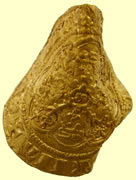 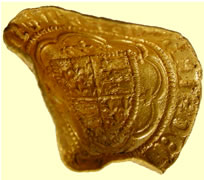 |
|||||||||||
1361-69 Edward III hammered gold qtr noble - treaty period - quatrefoil in centre:cross over shield 1.94g, 19.10 mm |
|||||||||||
 |
|||||||||||
|
|
||||||||||
c10thC Saxon harness strap fittings |
|||||||||||
  |
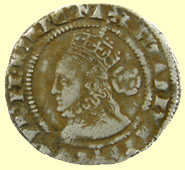 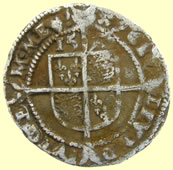 |
||||||||||
16thC Tudor clothing fastener |
1573-8 Elizabeth hammered silver 3 pence |
||||||||||
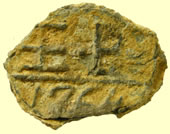 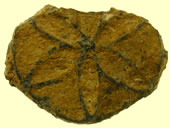 |
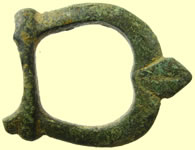 |
 |
|||||||||
First dated 18thC lead token I have seen dated 1754 |
1550-1650 buckle |
Military cap badge |
|||||||||
William IV, Prince of Orange-Nassau (1 September 1711 – 22 October 1751), born Willem Karel Hendrik Friso, was the first hereditary stadtholder of the Netherlands. Obv PRINS VAN ORANGE & NASSAU 3rd May 1747 |
|||||||||||
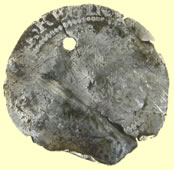 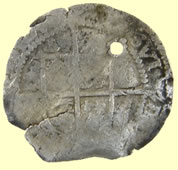 |
  |
||||||||||
16thC Elizabeth 1st hammered silver half groat |
Taco'd 13thC Medieval short cross hammered silver penny |
||||||||||
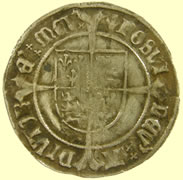 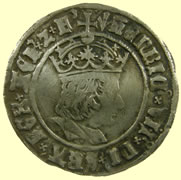 |
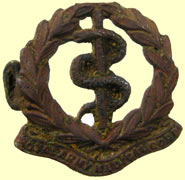 |
||||||||||
1505-9 Henry VII hammered silver groat - Pheon mintmark |
Royal Army mediecal corp |
||||||||||
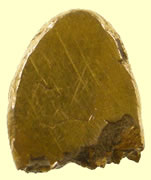 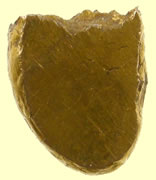 |
 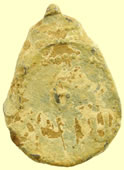 |
||||||||||
Ancient gold fragment - reported as treasure to museum - could be a Celtic qtr stater broken blank |
Dutch lead bale seal |
||||||||||
 |
|||||||||||
Medieval badges Ref Mitchiner p244 939 - 941
|
|||||||||||
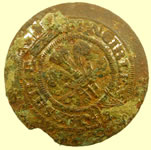 |
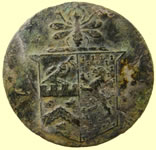 |
 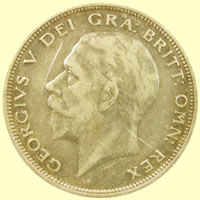 |
|||||||||
Military button |
Corporation button |
1932 George V milled silver half crown |
|||||||||
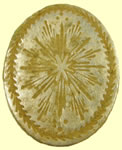 |
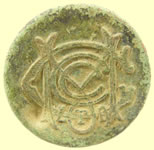 |
  |
|||||||||
Georgian silver cufflink |
Corporation button |
1215 Henry III hammered silver short cross penny Rev *E.ON.CA - Canterbury mint |
|||||||||
  |
 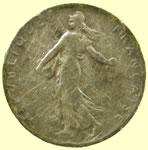 |
||||||||||
1280-86 Scottish Alexander III hammered silver penny -2nd issue |
1913 French coin - 50 centimes |
||||||||||
 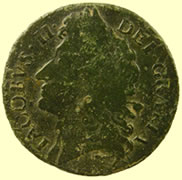 |
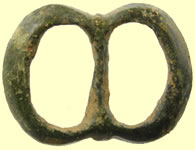 |
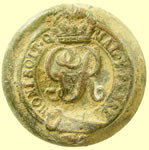 |
|||||||||
Irish 1689 James II emergency issue 'gun metal' shilling |
1550-1650 buckle |
20thC George V Army button |
|||||||||
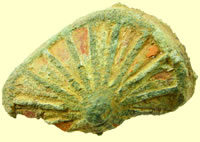 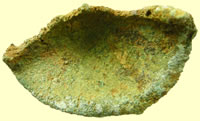 |
 |
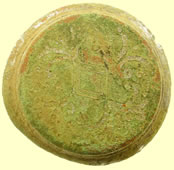 |
|||||||||
Romano/British enamelled disc brooch |
Interesting Navy button |
Georgian silver inlaid mount |
|||||||||
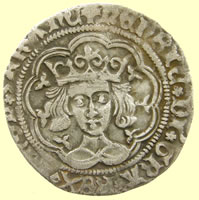 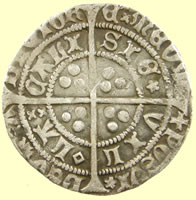 |
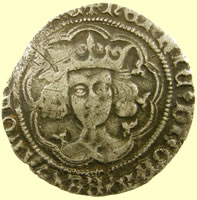 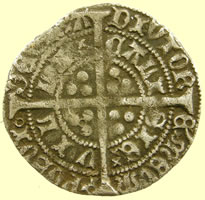 |
||||||||||
1430-1 Henry VI hammered silver groat- Rosette mascle issue- inital mark incurved cross Calais mint |
1422-30 Henry VI hammered silver groat- Annulet issue-Annulet in two qtrs on reverse - inital mark cross patonce Calais mint |
||||||||||
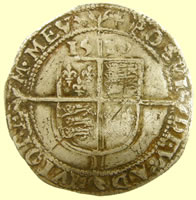 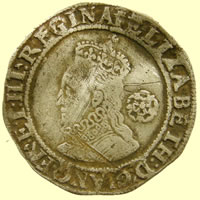 |
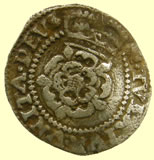 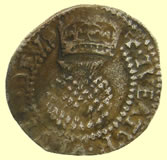 |
||||||||||
1580 Elizabeth 1st hammered silver sixpence - - Latin cross 5th issue |
1618-19 James 1st hammered silver half groat - Plain cross 2nd coinage |
||||||||||
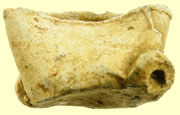 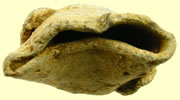 |
 |
||||||||||
1640's lead gunpowder measures and cap |
Excellent medieval religious mount - gold and red enamel remain |
||||||||||
|
 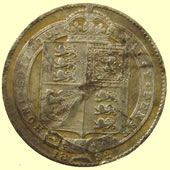 |
||||||||||
Victorian red and blue enamelled hair slide |
1892 Victoria milled silver shilling |
||||||||||
 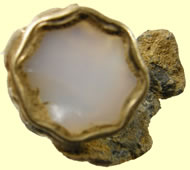 |
 |
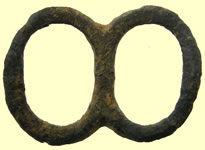 |
|||||||||
Fancy Victorian gold plated handle ? |
17thC sword belt fitting |
1550-1650 buckle |
|||||||||
  |
|||||||||||
Robert FitzWalter - enameled 13thC heraldic shield pendant Or a fess between two chevrons gules Robert le FizWalter
Because of the interdict, the churches closed and their bells fell silent. With the church doors locked, services could not take place. The dead had to be buried in fields instead of in holy ground. People could not marry in church and baptisms had to be carried out in church porches. King John's excommunication also let off the barons from their oath of loyalty to him. Because they might rebel against him at any time, King John acted quickly against anyone who looked as though they might be disloyal. We know from the Medieval Chronicles that Robert FitzWalter, the 3rd Lord of Dunmow Castle, was accused of plotting to kill King John during a rebellion in 1212. The rebellion was quickly quashed. FitzWalter was outlawed and fled to France. Eventually in 1213, the Pope told King Philip of France that he could invade England and King John finally agreed to the Pope's terms including his choice of Archbishop. Robert FitzWalter returned home and, with the other Barons, he made peace with King John. This did not last long, however. It was found that FitzWalter was still plotting against the King and urging for the government to be reformed. Because of this, his home in London, the Castle of Baynard, was almost entirely destroyed Taxes, during King John's reign, were very high and became ever higher. In 1214, King John left England to fight a war in France. To make sure the army had enough supplies, the king's Regent of the time, Peter de Roches, raised a very big tax on the barons. The war was lost and, as in the story, on the Kings' return, Robert FitzWalter called a meeting at Bury St Edmunds Abbey where it was agreed that the King must agree to the laws and freedoms granted to the barons in the charter of Henry 1st, or they would declare war on him. Robert FitzWalter led the Baron's army under the title "Marshal of the Army of God and the Holy Church." In the end, the King was forced to sign the Magna Carta at Runnymede on 15th June 1215. Several copies of the Magna Carta documents still exist. Magna Carta means 'great charter'. To abide by Magna Carta, the King had to agree to certain laws and accept that his will was not above the law. It was not the first written document that put limits on the power of a king, but it was the first that was backed up by a council (of 25 barons) to try and make sure the king obeyed. It included a paragraph that said 'no free man shall be seized, imprisoned, disposed, outlawed, exiled or ruined in any way ? 'except by the lawful judgment of his peers?' John did not sign the document willingly and never intended to keep to it. In September 1215, just a few months after signing the charter, King John sent a message to the Pope asking him to annul the charter. The Pope agreed and excommunicated the barons that had signed it. As the fighting started again, FitzWalter slipped off to France and offered Prince Louis the English throne. Both Scottish and French armies invaded England. After fighting off the Scottish forces, King John's army changed direction to East Anglia, intending to quash the baron's rebellion. As his troops crossed the river Ouse on 11th October, they were caught by the rising tide and the crown Jewels sank into the Wash. Just a few days later, on 19th October, King John died at Newark. At the time of his death, the French flag flew over East Anglia. However, a French King did not rule England as no bishop would crown Prince Louis and many of the barons, who had rebelled against King John, now gave their support to his nine-year-old son Henry.
At the start of his reign, while he was away from England, he left Geoffrey FitzPeter in control as 'Regent'. He was a harsh man and did not worry about demanding heavy taxes and gave the local sheriffs a free hand to collect these by any means. He became very unpopular. Like most Kings of the time John was ruthless. It was also claimed that King John killed his nephew, Arthur, in 1206, to make sure of the future of the throne. However, history may not have been very fair to King John. At this time the historians, or chroniclers, were mainly monks. These monks would have been in sympathy with the parties that King John was arguing with - that is the church and the rich estate owners (barons). King John's reign was far from all bad for the country. Many towns such as Cambridge, Ipswich, King's Lynn and Norwich grew rich as they were given 'charters' and encouraged to govern themselves. The towns benefited from changes in the way taxes were paid and could get income from taxing market traders entering the town. R. Turner 1994 argued that John "...had intelligence, administrative ability and he was good at planning military campaigns. However, too many personality flaws held him back". Unfortunately for King John, no king of the time could have run the country successfully without the support of the powerful Barons and Noblemen. What of Matilda's supposed murder and her links with Robin Hood?
Matilda, his daughter, may indeed have been beautiful but very little is known of her life and death. After the rebellion of 1212, when FitzWalter and his family fled to France, it seems that he made his actions seem good, by saying the king was after his daughter and was plotting to kill his son-in-law. King John was not a pleasant man, but many historians do not believe FitzWalter's story. Robert FitzWalter had a shady past. He had surrendered Vaudreuil in France to the French king in 1203 under suspicious circumstances. So, whether what he did was because of King John's interest in his daughter or came from a wish for more power is difficult to say. The character of Maid Marion, like Friar Tuck, is not in the early ballads of Robin Hood. The character of Maid Marion probably came from an early French Pastoral romance ??he shepherd and shepherdess Robin and Marion'. Parts of this story and the Robin Hood stories probably merged and Maid Marion became Robin Hood's true love in the later versions of the legend. It is in Anthony Munday's Elizabethan "Huntingdon" plays; written in the 17th century that Marian becomes an alias employed by Matilda FitzWalter. A popular romance at the time was the legend of King John pursuing Matilda, daughter of Robert FitzWalter. Robin Hood or Robin of Loxley, if such a person existed, was not a well-known Nobleman but most likely a wronged landowner, fighting to regain his family seat. Dunmow Priory in Essex is said to be the resting-place of Robin Hood's Maid Marian. All that remains of Dunmow Priory is the present church of Dunmow; the south aisle of what was once a much larger building. However the story lives on, along with the many other tales of Robin Hood; and King John's jewels and royal regalia remain a treasure trove still to be found. |
|||||||||||
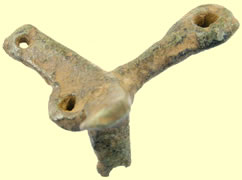 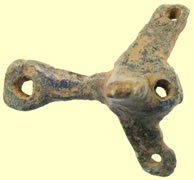 |
|||||||||||
Interesting medieval widget - one for the museum |
|||||||||||
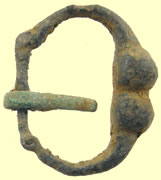 |
 |
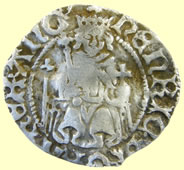 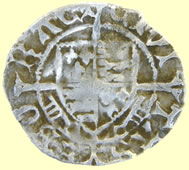 |
|||||||||
Medieval buckle |
Silver inlaid early buckle fragment - checking the ref books |
1485 Henry VII hammered silver sovereign penny - keys below shield - Archb Rotherham Obv CIVI/TAS/EBO/RACI - York mint |
|||||||||
 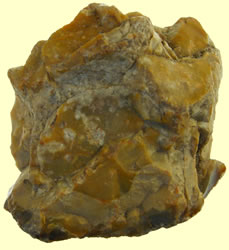 |
|||||||||||
Really neat fossil eyeball find |
|||||||||||
 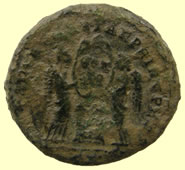 |
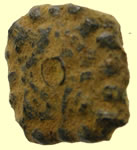 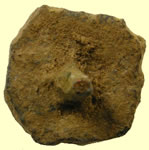 |
||||||||||
Mid 4th House of Conatantine Roman bronze coin |
Medieval mount - single rivet fixing |
||||||||||
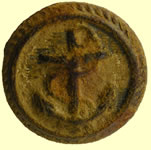 |
 |
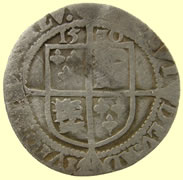 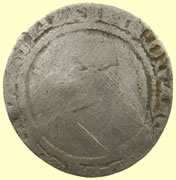 |
|||||||||
Navy button |
Georgian decorated watch winder |
1560 Elizabeth hammered silver sixpence |
|||||||||
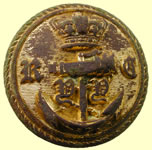 |
 |
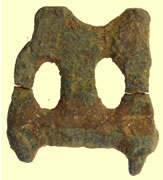 |
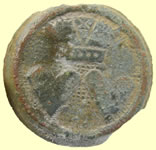 |
||||||||
Royal Navy yacht club |
15thC casket key |
c10thC Saxon stirrup mount - top fragment |
17thC Charles II base metal copy of silver commemorative marriage button |
||||||||
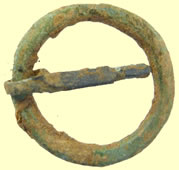 |
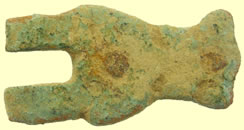 |
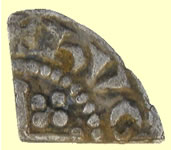 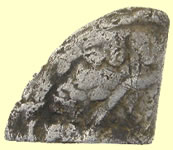 |
|||||||||
Medieval annular buckle |
Medieval buckle plate with 2 rivet fixings |
1215 Henry III hammered silver qtr penny |
|||||||||
 |
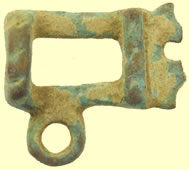 |
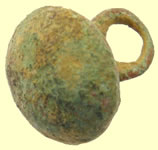 |
 |
||||||||
17thC clothing fastener |
17thC sword belt fitting |
17thC button
|
Medieval bucket handle loop |
||||||||
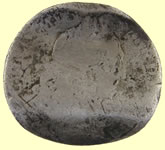 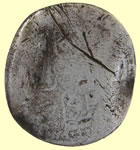 |
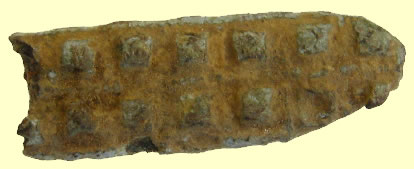 |
||||||||||
1696 William III milled silver sixpence - love token |
Roman strap end fragment |
||||||||||
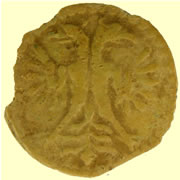 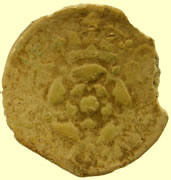 |
 |
||||||||||
1603 James 1st lead token |
18thC musket ramrod guide |
||||||||||
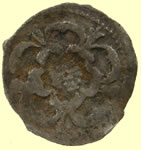 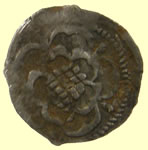 |
 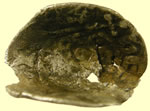 |
||||||||||
Probably one of the smallest hammered silver coins you can find, 1/3rd the weight of a Medieval silver farthing 1625-42 Charles 1st hammered silver half penny - Rose each side - no legend type
|
1215 Henry III hammered silver shortcross penny |
||||||||||
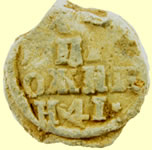 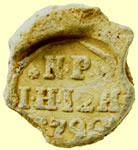 |
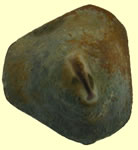 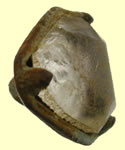 |
||||||||||
1790 Russian lead bale seal |
Victorian copper alloy stud with glass tone |
||||||||||
 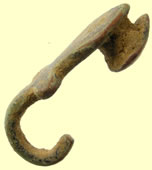 |
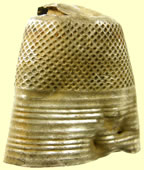 |
 |
|||||||||
1300-1600 composite mount. |
Georgian silver thimble |
Medieval strap end with buckle |
|||||||||
  |
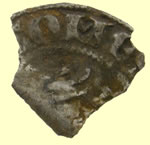 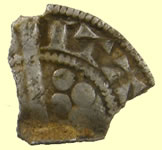 |
||||||||||
1341 Edward III hammered silver penny Rev CIVI/TAS/LON/DON - London mint |
Legend is very odd - Obv OME and Rev ITA ??? Not in the books |
||||||||||
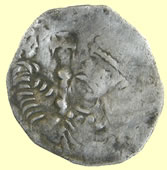 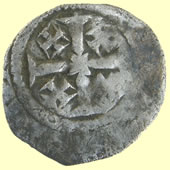 |
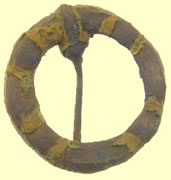 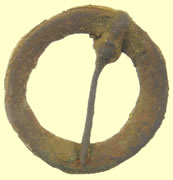 |
||||||||||
1163-1167 Henry II hammered silver penny -Tealby coinage - Cross and Crosslets Class C |
Medieval gold decorated annular brooch - blue enamelling remains |
||||||||||
  |
|||||||||||
Medeival lead bird feeder bowl with decorated base |
|||||||||||
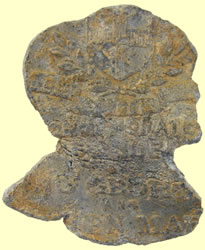 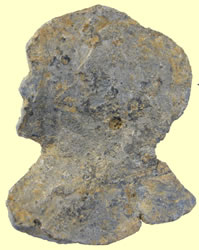 |
|||||||||||
Lead bust shaped medallion - London shield - Rev has 2 busts facing left 'King George and men may' |
|||||||||||
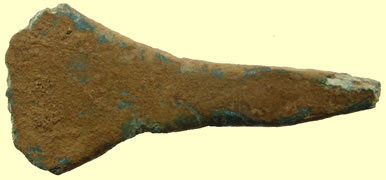 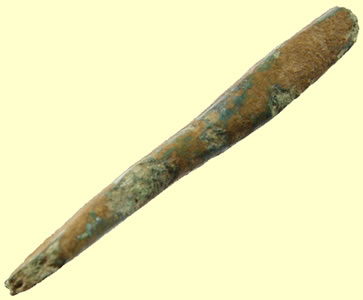 |
|||||||||||
C1000 BC Miniature Bronze Age votive axe head 9.98g, 46.22mm |
|||||||||||
 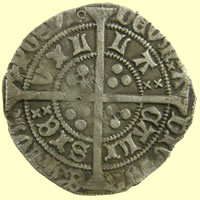 |
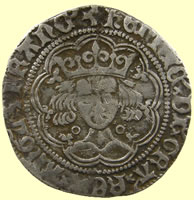 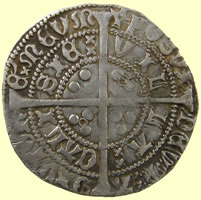 |
||||||||||
1422-27 Henry VI hammered silver groat- Annulet issue-Annulet by neck in two qtrs on reverse - inital mark pierced cross Calais mint |
1422-27 Henry VI hammered silver groat- Annulet issue-Annulet by neck in two qtrs on reverse - inital mark pierced cross Calais mint |
||||||||||
Interesting to note - same coin different dies |
|||||||||||
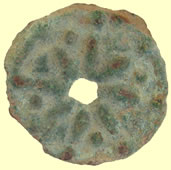 |
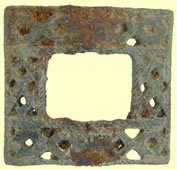 |
 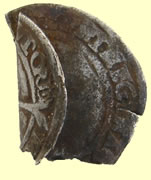 |
|||||||||
Medieval decorated mount - single rivet fixing |
17thC buckle |
1565 Elizabeth 1st hammered silver sixpence |
|||||||||
 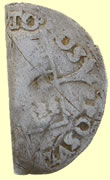 |
 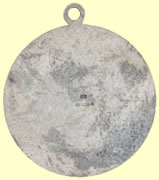 |
||||||||||
1553 Mary hammered silver groat |
20thC St Christopher silver pendant |
||||||||||
  |
  |
||||||||||
1788 George III guinea gaming token 'the good old days' |
Medeival gilded mount |
||||||||||
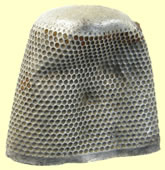 |
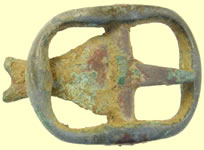 |
 |
|||||||||
Georgian silver thimble |
Georgian spur buckle |
Sponge fossil - UPPER CRETACEOUS PERIOD: 83 - 71 million years ago |
|||||||||
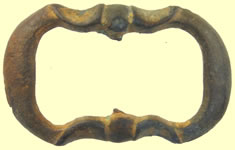 |
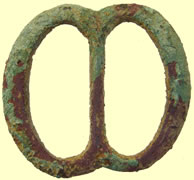 |
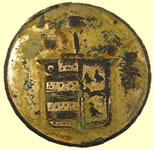 |
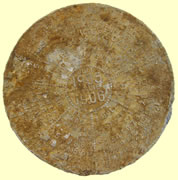 |
||||||||
17thC buckle |
1550-1650 buckle |
Corporation button |
1905-6 Calender medallion |
||||||||
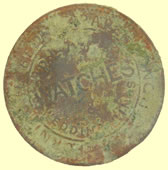 |
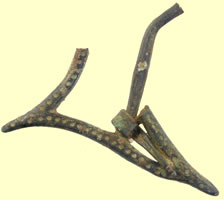 |
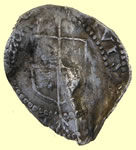 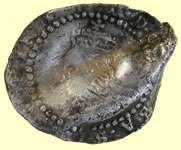 |
|||||||||
20thC Bedwell Colchester trade token |
Unusual red enamelled medieval buckle with circle decoration |
16thC Elizabeth 1st hammered silver penny |
|||||||||
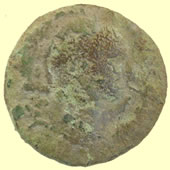 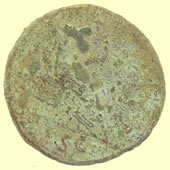 |
 |
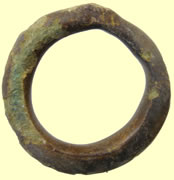 |
|||||||||
134AD Hadrian roman bronze coin |
Roman pin head |
Bronze age harness ring |
|||||||||
 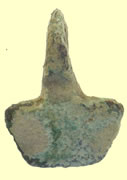 |
 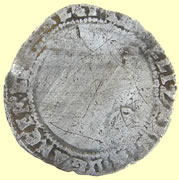 |
||||||||||
Medieval harness shield pendant |
1582 Elizabeth 1st hammered silver sixpence |
||||||||||
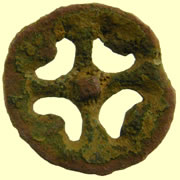 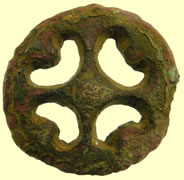 |
|||||||||||
Gold plated medieval mount - single rivet fixing |
|||||||||||
|
|||||||||||
Very interesting hollow Roman bronze votive offering animal - red enamelled on head on nose 3 cut outs to rear 38mm L x 27.8mm H - 10.06g |
|||||||||||
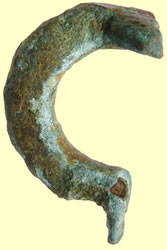 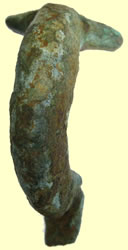 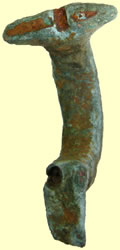 |
|||||||||||
Red enamelled 3rd C Roman crossbow brooch 24.46g, 39.74mm |
|||||||||||
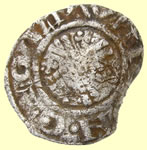 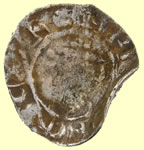 |
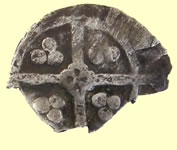 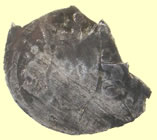 |
||||||||||
1215 Henry III hammered silver short cross penny |
1413 Henry V hammered silver penny - quadrefoil with pellet on rev York archbishop issue |
||||||||||
|
|||||||||||
Stunning find - Celtic dragon headed toggle clothing fastener - 42.55mm L x 36.99mm H 27.37g |
|||||||||||
  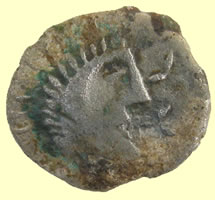 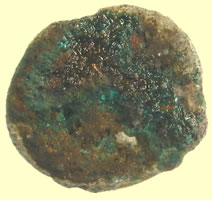 |
|||||||||||
As dug to partially cooked Celtic silver coin - East Anglian face horse type Straight back into the 'cooker' to remove the rest of the crust |
|||||||||||
As dug and partially 'cooked'
Almost 'cooked' , below is Mark Lehman's initial ID, I have resent it to him now I have 'cooked' it better You seem to be getting a lot of unintended small change lately - This is a denarius of Severus Alexander - the last member of the Severan Dynasty, 222-235 AD. This one should read: IMP C M AVR SEV ALEXAND AVG on the obverse and ANNONA AVG on the reverse. In addition to the missing parts, there seems to be either a squashed letter "A" or a letter "I" in error at the end of ANNONA. Annona was the allegorical personification of the grain supply - yes, it was THAT important to the Romans so that it required a minor deity to be "in charge" of imported grain. She's shown holding a handful of grain-ears and a cornucopia. What I can't tell is whether she has her foot on a ship's prow or there's a modius - a grain-measure basket - at her feet since that bit is missing. If it's the ship's prow, this coin dates to 228 - if it's the modius, it's 226. For our purposes, we can assume that all the silver was struck at the mint in Rome at this point in time.
|
|||||||||||
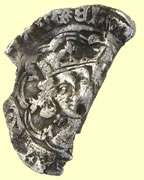 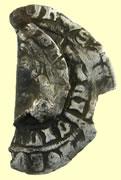 |
Still 'cooking' the coin
|
||||||||||
1485 - 90 Henry VII hammered silver groat - Satires by neck - Halved sun and rose initial mark - Open crown - Type 1b |
32 BC Mark Antony, Legionary silver Denarius. ANT.AVG.III.VIR.R.P.C Galley, Legionary Eagle between two standards |
||||||||||
  |
|||||||||||
This medieval quadrefoil pendant has been soaking for 3 weeks and finally I got the detail to come through - stunning red and green enamelled lion with fluer de lis more work to do on it yet |
|||||||||||
Medieval badges Ref Mitchiner p244 939 - 941
|
|||||||||||
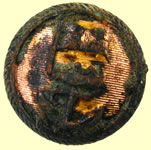 |
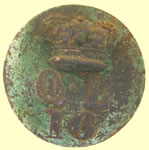 |
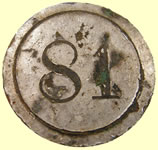 |
|||||||||
Shipping line button |
|
18thC 81st regiment of foot - officers button The 81st was raised in 1793 in response to the French Revolution. The British Army was in the process of being expanded to meet the French Republican threat.On 23 September 1793, Major General Albemarle Bertie, formerly of the 1st Foot Guards, was directed to raise a regiment. However, no levy money would be provided. The original compliment was composed of the Militia of Lincoln volunteering to serve in the new regiment. Originally known as the Loyal Lincoln Volunteers, the regiment was embodied in January 1794. On 25 January 1794, the Loyal Lincoln Volunteers were re designated as the 81st Regiment of Foot. The regiment was quartered in Lincoln and Gainsborough. The first commander was Lieutenant Colonel Lewis. |
|||||||||
19thC livery buttons |
|||||||||||
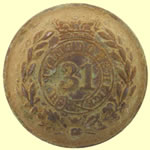 |
 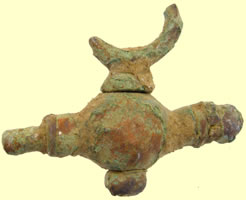 |
||||||||||
The 31st (Huntingdonshire) Regiment of Foot was an infantry regiment of the British Army formed in 1702 and amalgamated into the The East Surrey Regiment in 1881 |
Medieval purse bar swivel joint |
||||||||||
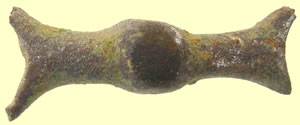 |
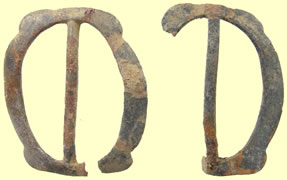 |
||||||||||
c10thC Saxon harness cheek piece |
2 - 1350 to 1650 buckles |
||||||||||
  |
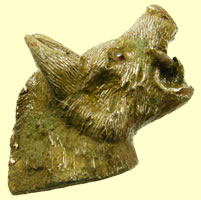 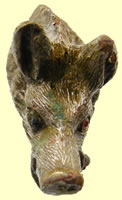 |
||||||||||
c10thC Saxon brooch |
Very interesting boar's knife pommel find - silver on copper with red glass eyes Not sure of date so one for the museum |
||||||||||
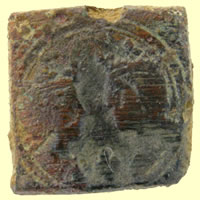 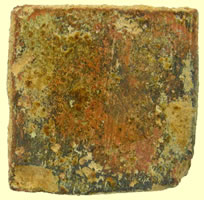 |
|||||||||||
1469-1504 Ferdinand and Isabella - British weight for an excellente 17.71mmsq, 6.21g |
|||||||||||
 |
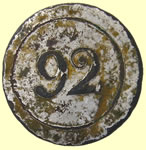 |
 |
 |
||||||||
19thC Army button - not deciphered lettering yet |
|
RN Capt / Commander - 1812 RN Lieutenant - 1812 RN Midshipman - 1812 RN Volunteer Gr.I - 1812 After this issue a Midshipman will have the Captain's style |
19thC livery button |
||||||||
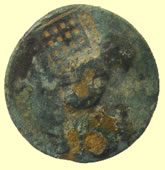 |
 |
||||||||||
1770 - bullion weight - Westminster portcullis mark
|
18thC casket key
|
||||||||||
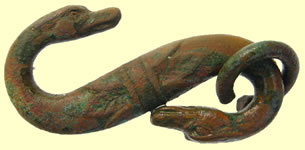 |
 |
||||||||||
16thC serpent buckle
|
Medeival buckle |
||||||||||
|
|
|||||||||||
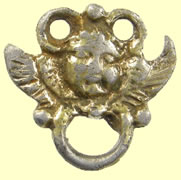
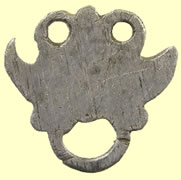
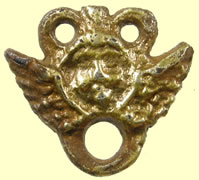
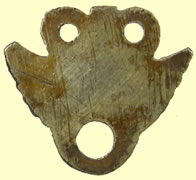
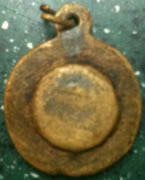
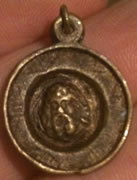

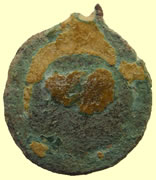
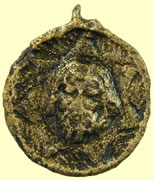
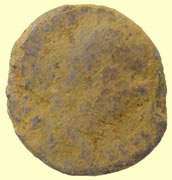

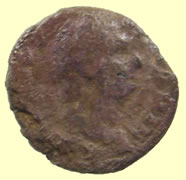
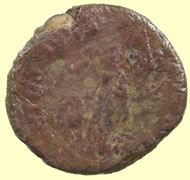
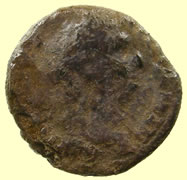

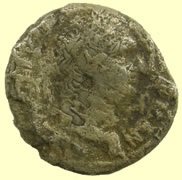
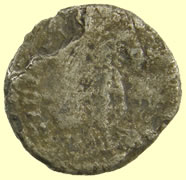
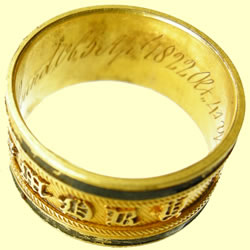
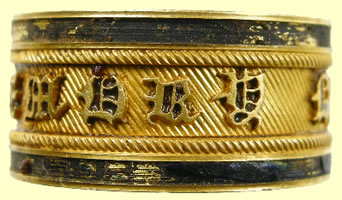
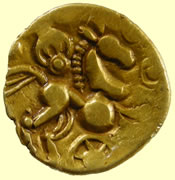
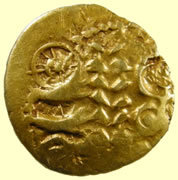
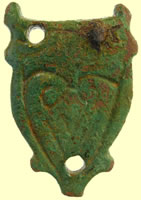
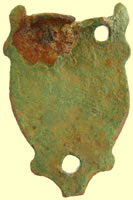

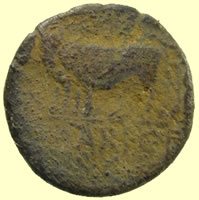
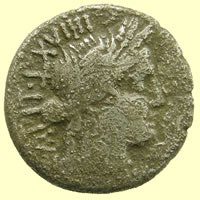
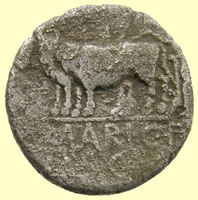



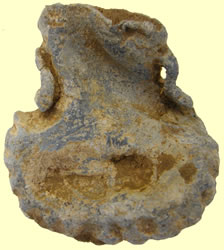
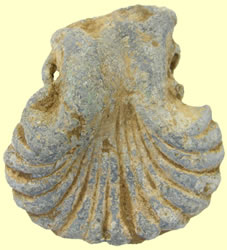
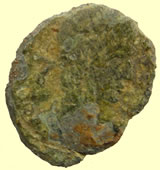
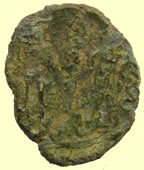
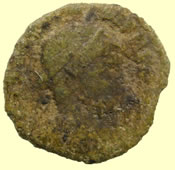
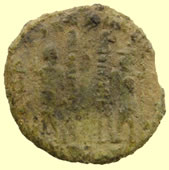
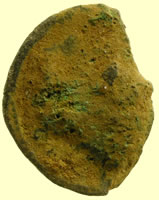
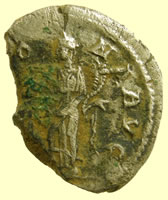
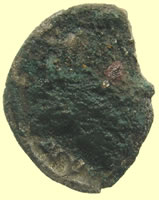
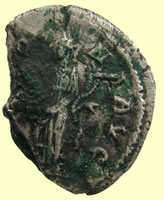

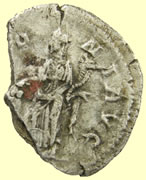
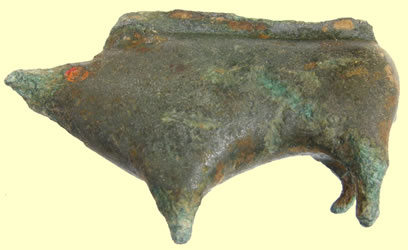
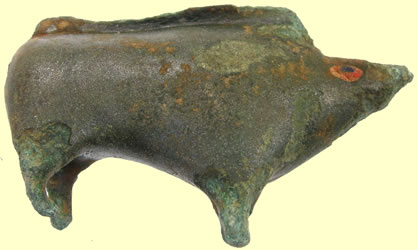
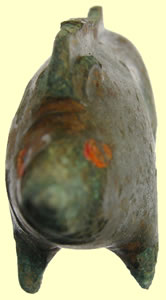

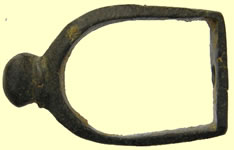


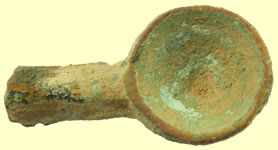
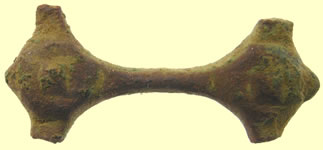
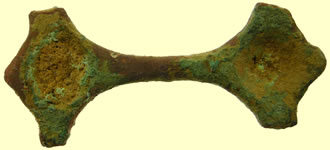
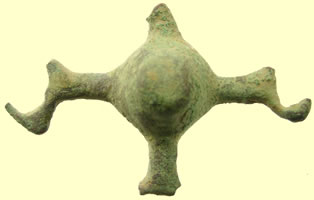

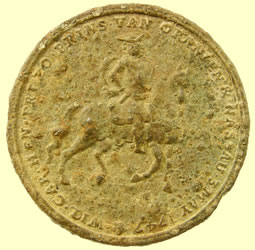
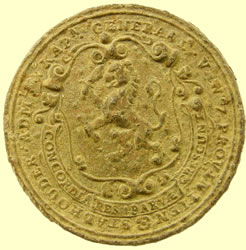
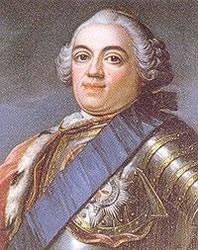
 'A badge for a Knight of the Order of the Holy Sepulchre in bronze and dating somewhere around C13/14th possibly very slightly later . This is a very scarce item and it relates to The Equestrian Order of the Holy Sepulchre of Jerusalem being a Catholic chivalric order of Knighthood that traces its roots to Godfrey of Bouillon, principal leader of the First Crusade. According to reliable sources in the Vatican and Jerusalem, it began in historical reality as a mixed clerical and lay confraternity (association) of pilgrims which gradually grew around the most central of the Christian holy places in the Middle East, the Holy Sepulchre or the tomb of Jesus Christ.This would have been a pin for a member of the order , there is a mark on the reverse where the original pin would have been fixed '
'A badge for a Knight of the Order of the Holy Sepulchre in bronze and dating somewhere around C13/14th possibly very slightly later . This is a very scarce item and it relates to The Equestrian Order of the Holy Sepulchre of Jerusalem being a Catholic chivalric order of Knighthood that traces its roots to Godfrey of Bouillon, principal leader of the First Crusade. According to reliable sources in the Vatican and Jerusalem, it began in historical reality as a mixed clerical and lay confraternity (association) of pilgrims which gradually grew around the most central of the Christian holy places in the Middle East, the Holy Sepulchre or the tomb of Jesus Christ.This would have been a pin for a member of the order , there is a mark on the reverse where the original pin would have been fixed '